WOE Dispatch

A Venezuelan Oil Company's Tudor Submariners
How Venezuela’s National Oil Industry Quietly Issued Tudor Submariners to Working Divers - Over the weekend, as headlines filled with images of helicopters, explosions, and...
Read OnHow Venezuela’s National Oil Industry Quietly Issued Tudor Submariners to Working Divers - Over the weekend, as headlines filled with images of helicopters, explosions, and the arrest of Nicolás Maduro, Venezuela once again reminded the world that power often flows through oil. At Watches of Espionage, we often use watches as a lens to view history and current events. With that in mind, we want to take a look at a little-known story of horology history: the watches that supported the divers of Lagoven Sociedad Anónima, a state-owned Venezuelan oil company that operated from 1976 until the late 1990s.
Read On
Professional Diver Explains How To Use A Dive Watch
Despite its prominence, the dive watch is surprisingly misunderstood, especially as it relates to actual diving. Backed by my experiences in commercial and recreational scuba...
Read OnDespite its prominence, the dive watch is surprisingly misunderstood, especially as it relates to actual diving. Backed by my experiences in commercial and recreational scuba diving, in this Dispatch, I’ll unpack how to use a dive watch for actual diving, touching on historical use cases, the modern role played by dive watches juxtaposed against diving computers, a few special scenarios, and even some myths.
Read On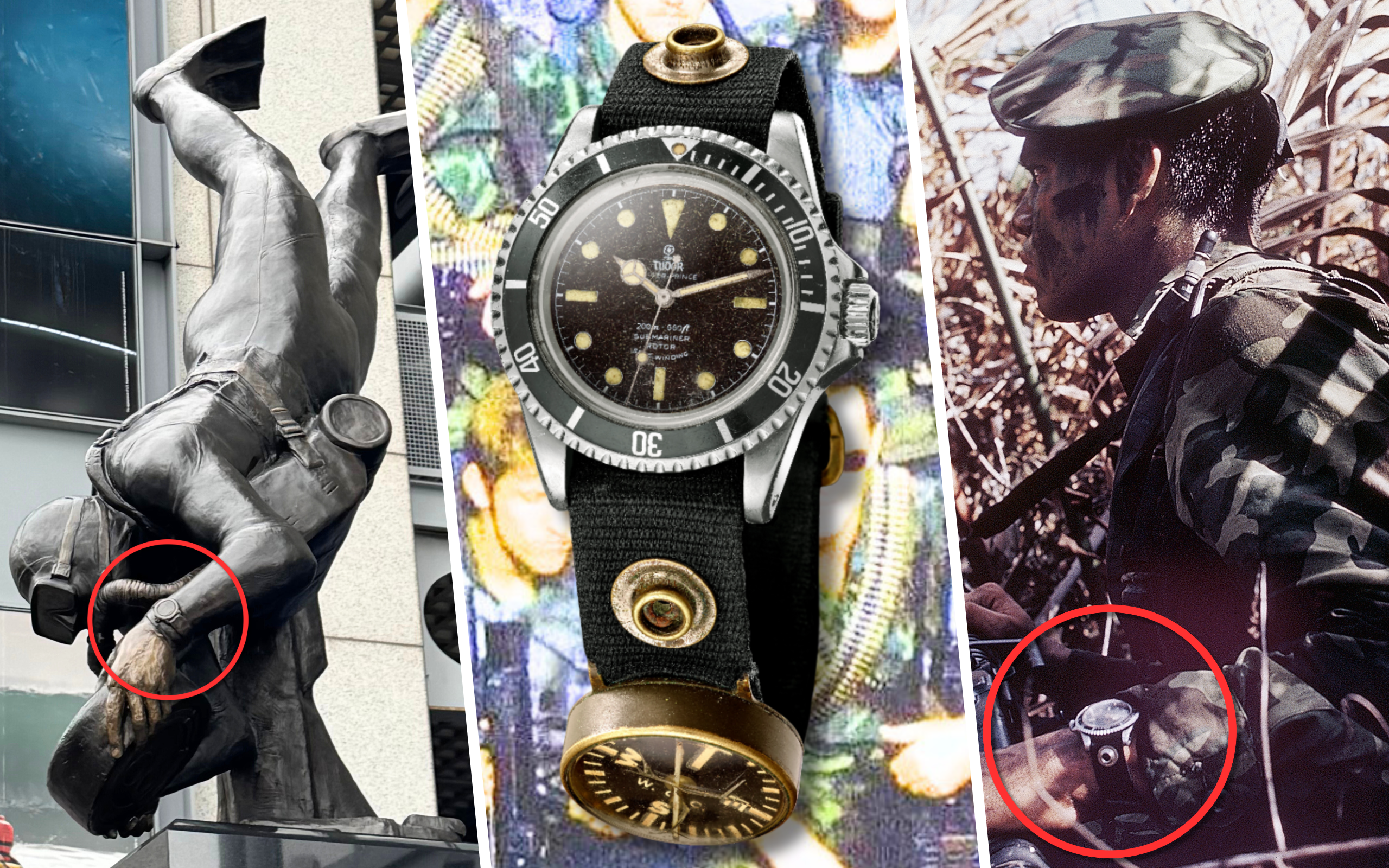
The SEAL Museum: Tudor Submariners Through the Decades
Tudor partners with the new Navy SEAL Museum in San Diego, creating realistic displays of issued watches - This weekend, I had the opportunity to...
Read OnTudor partners with the new Navy SEAL Museum in San Diego, creating realistic displays of issued watches - This weekend, I had the opportunity to visit the newly minted Navy SEAL Museum in San Diego, a short drive from the west coast Teams and Coronado, where generations of frogmen were forged in the crucible of BUD/S.
Read On
The Watches Of The Terminal List: Dark Wolf
Carefully Selected Timepieces From Tudor, G-Shock, Seiko, Panerai, Citizen, & RESCO Add Depth To Jack Carr’s Characters - The Terminal List: Dark Wolf takes Jack...
Read OnCarefully Selected Timepieces From Tudor, G-Shock, Seiko, Panerai, Citizen, & RESCO Add Depth To Jack Carr’s Characters - The Terminal List: Dark Wolf takes Jack Carr’s universe deeper into the shadows, with Taylor Kitsch returning as Ben Edwards in a prequel that explores his transition to shadowy CIA operative after a troubling exit from the SEAL Teams.
Read On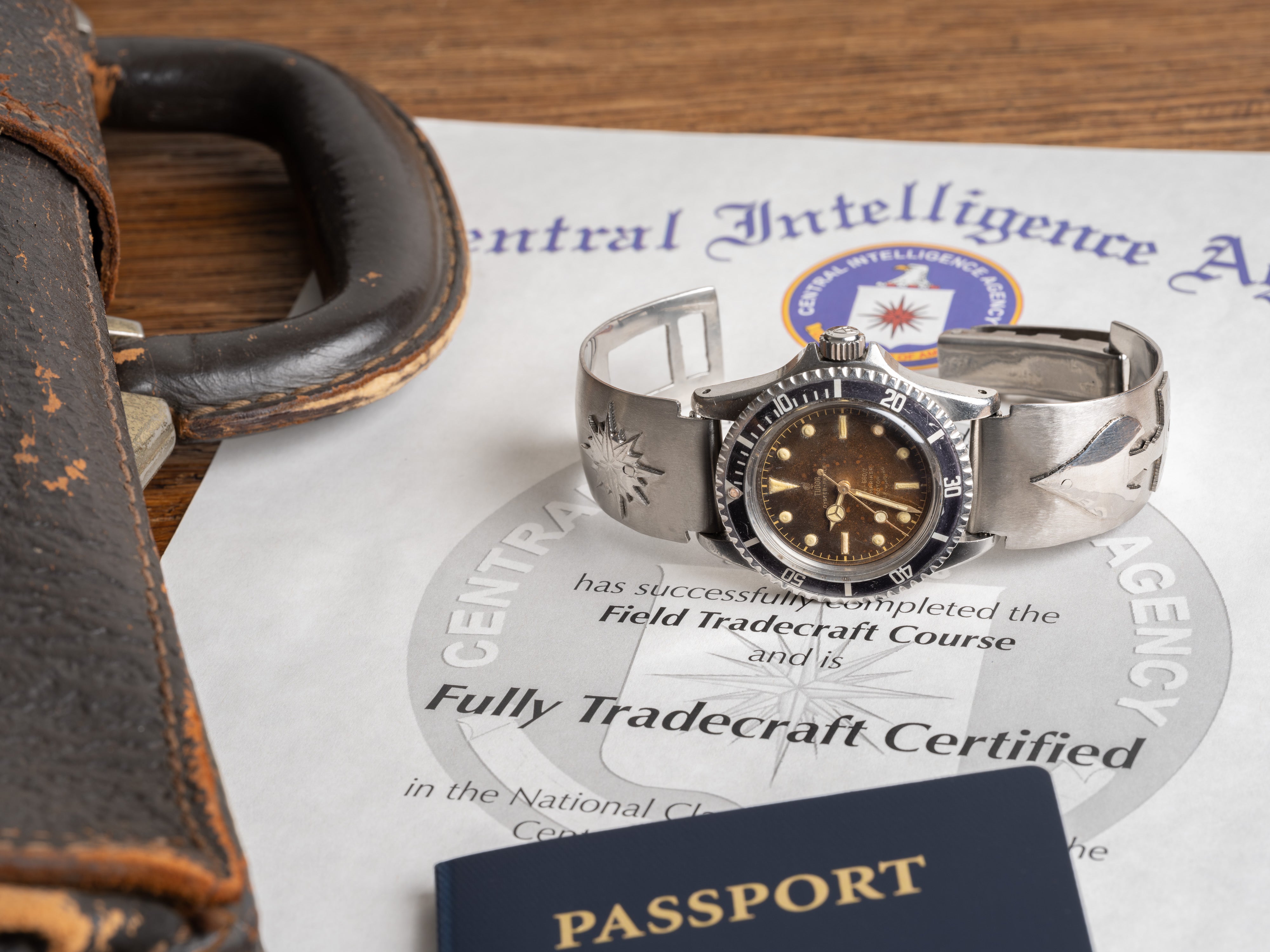
Olongapo Bracelets Of The Vietnam War & Today
The Story Behind the Olongapo Bracelet - The Vietnam-Era Tradition That Still Resonates With Collectors and Veterans Today
Read OnThe Story Behind the Olongapo Bracelet - The Vietnam-Era Tradition That Still Resonates With Collectors and Veterans Today
Read On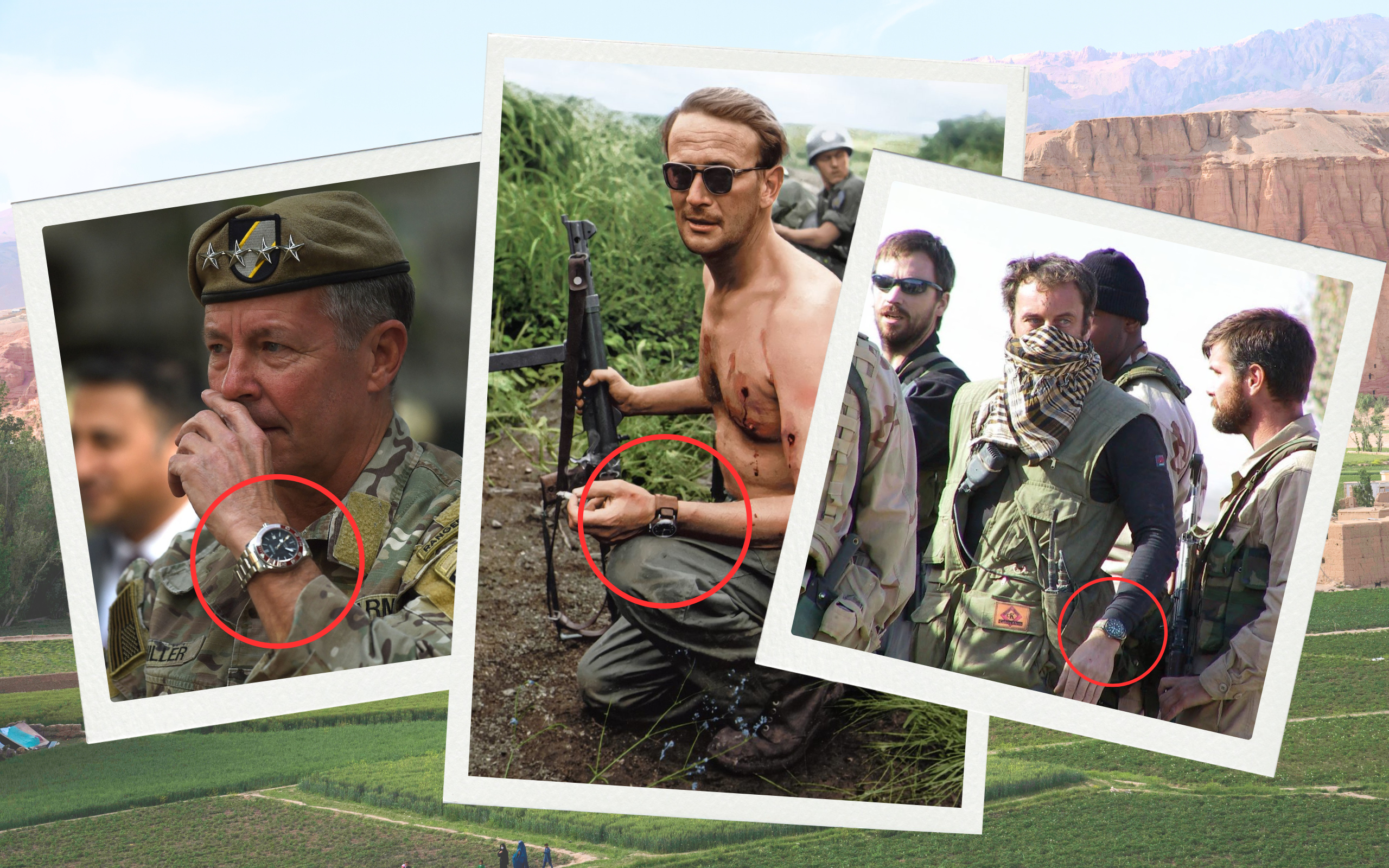
Military & Intelligence Watch Spotting
The Most Fascinating In-The-Wild Watch Photos From Watches Of Espionage - W.O.E. is about watches, and we love watches, but it's really about people, heritage,...
Read OnThe Most Fascinating In-The-Wild Watch Photos From Watches Of Espionage - W.O.E. is about watches, and we love watches, but it's really about people, heritage, and culture. We view the world through the lens of timepieces and use them as a vector to the human element for history and current events.
Read On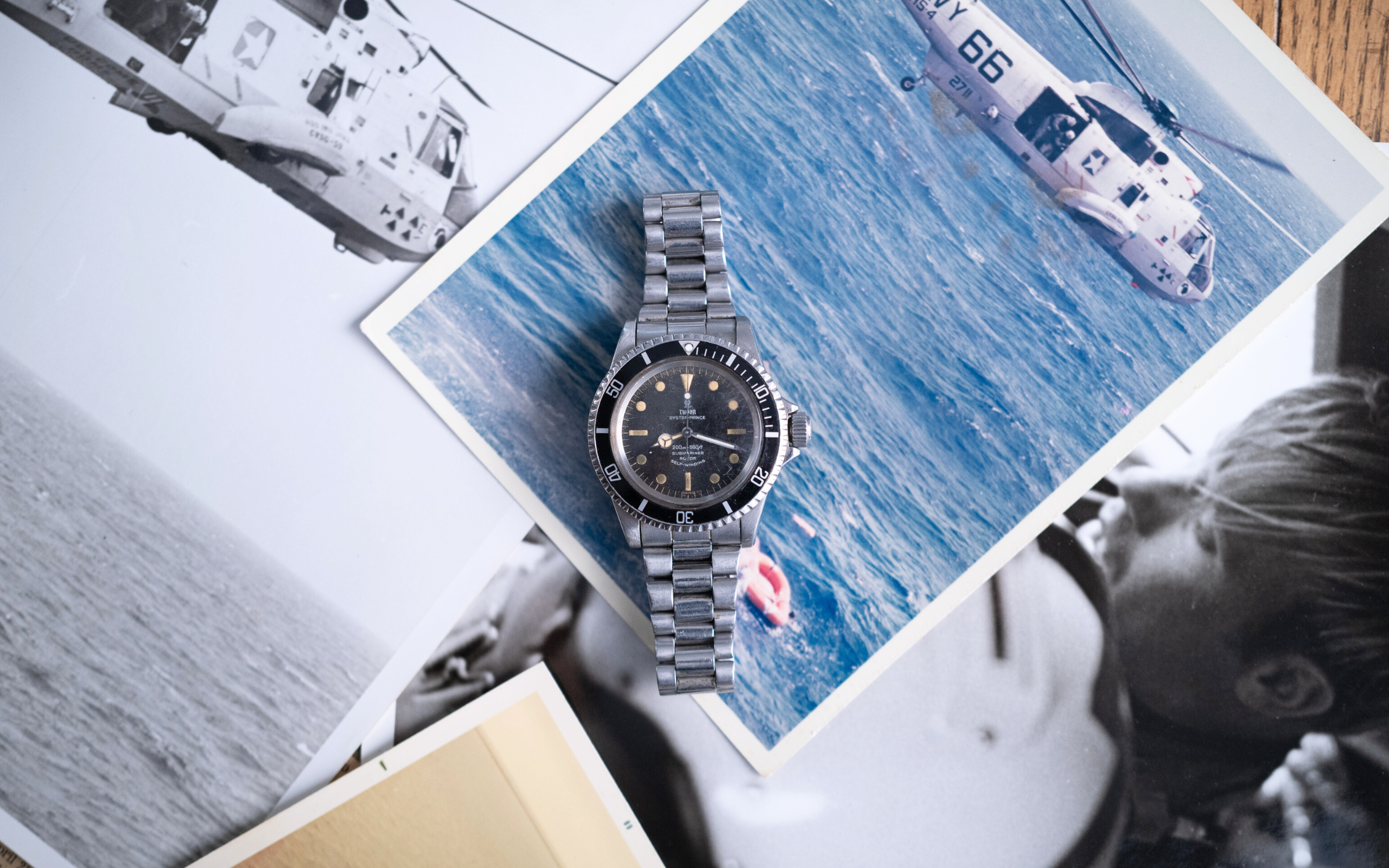
Tudor: Splashdown - The Little-Known Story Of Navy Frogmen & The Space Program
A Behind-The-Scenes Look At Tudor’s New Documentary, W.O.E. On The Set - In a conference room deep in the bowels of a storied aircraft carrier...
Read OnA Behind-The-Scenes Look At Tudor’s New Documentary, W.O.E. On The Set - In a conference room deep in the bowels of a storied aircraft carrier that now serves as a museum, I remove my Tudor Submariner 7928 from my wrist.
Read On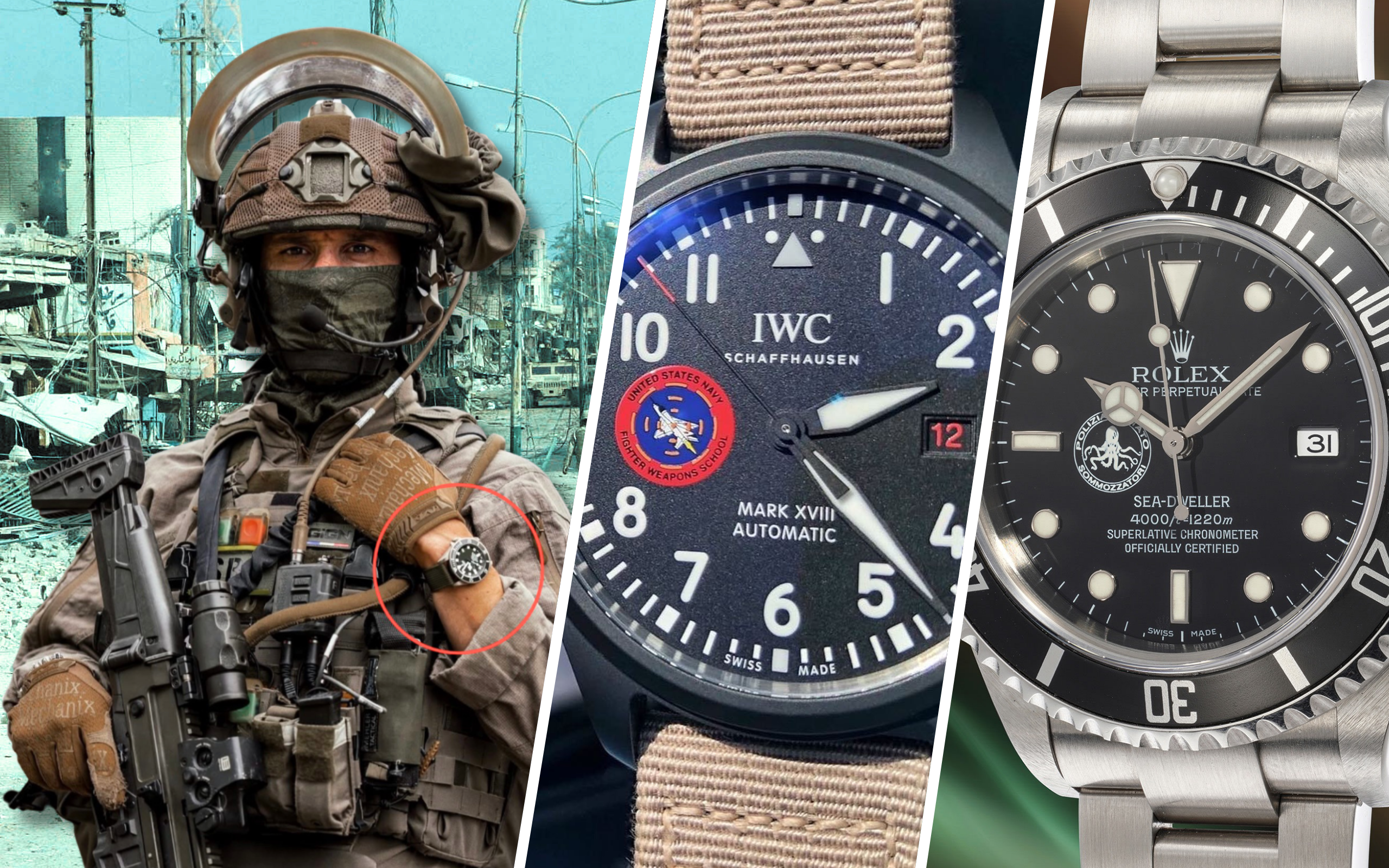
The Best Military and Intelligence Unit Watches
Customized Timepieces From Rolex, Breitling, Tudor, Bremont, & Omega - In the W.O.E. community, military “unit watches” are at the heart of modern watch culture.
Read OnCustomized Timepieces From Rolex, Breitling, Tudor, Bremont, & Omega - In the W.O.E. community, military “unit watches” are at the heart of modern watch culture.
Read On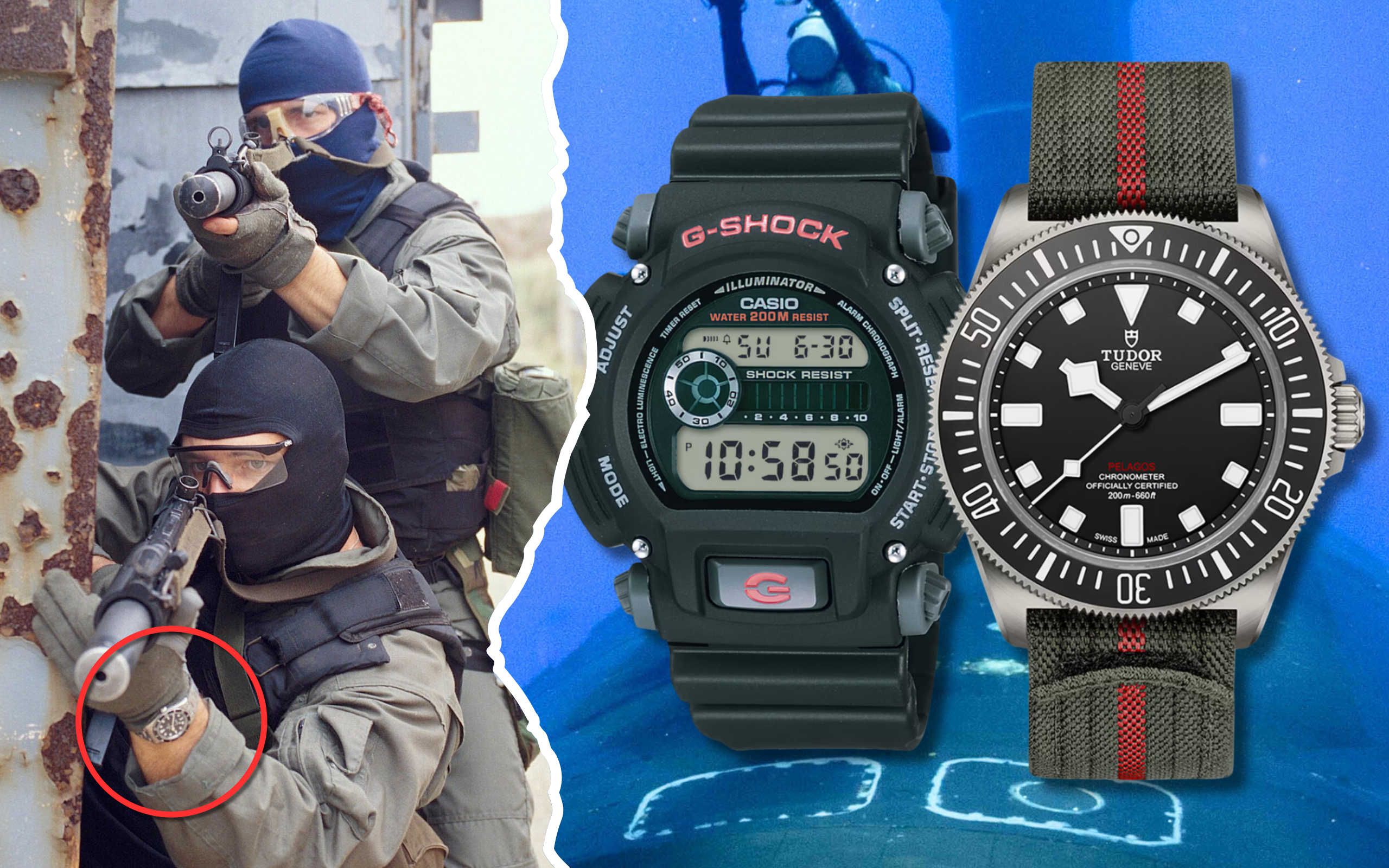
The Real Watches Of Navy SEALs
The Tudor, G-Shock, Seiko, & Omega Watches Actually Used By Naval Special Warfare - For decades, Navy SEALs lived in the shadows as quiet professionals,...
Read OnThe Tudor, G-Shock, Seiko, & Omega Watches Actually Used By Naval Special Warfare - For decades, Navy SEALs lived in the shadows as quiet professionals, an often unheralded weapon in the US Military arsenal.
Read On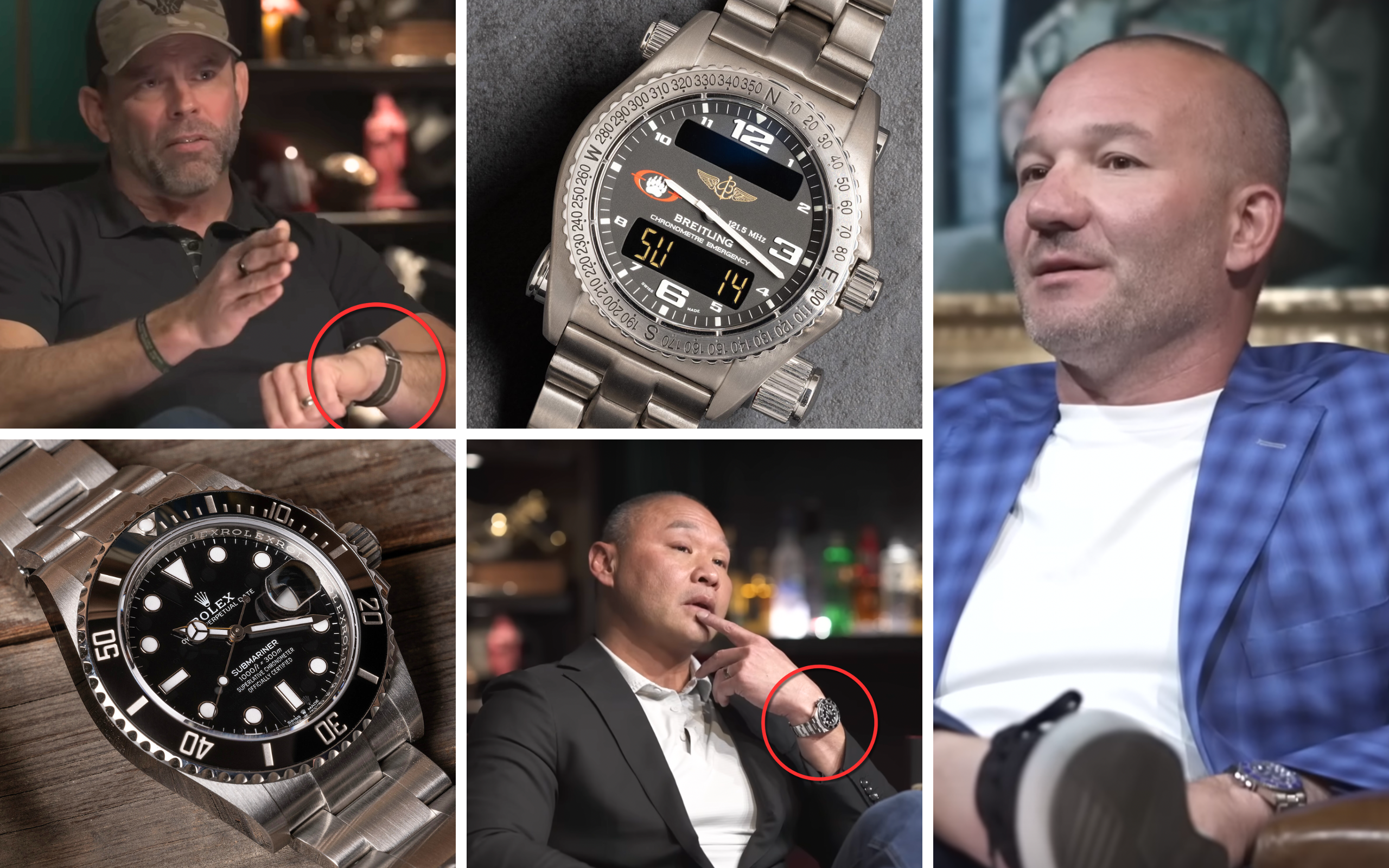
Watches Of The Shawn Ryan Show
Unfiltered Conversations With America’s Elite Warriors Offer Unique Insight Into Military Watch Culture The Shawn Ryan Show has exploded in popularity in recent years and...
Read OnUnfiltered Conversations With America’s Elite Warriors Offer Unique Insight Into Military Watch Culture The Shawn Ryan Show has exploded in popularity in recent years and grown into a media platform amassing some 16M views per month. Shawn, a former SEAL and CIA GRS contractor, is known for diving deep into politics, but the podcast started almost solely focused on interviewing practitioners from the SpecOps and Intel community. The guests of over 200 episodes are a who’s who of the tactical and veteran media personality world, which has no shortage of drama. That said, the episodes are more than just war stories and often touch on important issues including the mental tolls of combat, addiction, and PTSD. But what really interests us is the unique insight the show offers as it relates to the watches worn by individuals from our community, both during and after service. Like much of the content on W.O.E., this is about culture as much as anything else. Shawn himself is also at least something of a watch nerd, owning several Rolex references and a Blackwater Breitling (He was a former BW contractor). He’s discussed what constitutes a solid watch for escape and evasion purposes and also commonly asks guests about the watches on their wrists. Dallas Alexander - Tudor Unit Watch - Episode 047 Dallas Alexander was a member of Joint Task Force 2 (JTF 2), Canada’s tier-one special operations unit. Dallas is now known for his involvement in a world-record sniper shot conducted in Mosul, Iraq in 2017 at an astonishing 3,540 meters. Throughout his Shawn Ryan interview, Alexander wears a Tudor unit watch version of the Pelagos customized with JTF 2’s insignia on the caseback as well as a maple leaf and “Facta Non Verba”, Latin for “Deeds Not Words”, on the dial. Alexander’s JTF 2 Tudor Pelagos. We reached out to Dallas after seeing him and his watch on the podcast, and the 14-year veteran of JTF 2 was quick to say that he was “not much of a watch guy,” but found the timepiece meaningful. Dallas has since left the unit, finding a second career in country music, and the watch can be seen on his wrist regularly as he performs, a constant reminder of his past service. Dale Stark - Breitling - Episode 142 Proof that Shawn doesn’t only interview current and former SOF dudes is Dale Stark, a former enlisted Air Force mechanic who later earned his commission to become an A-10 Warthog pilot, and later deployed to Afghanistan in 2006, 2010, and 2014. During the podcast, Stark wears a timepiece from Wassan Watch Co., but it is his Breitling Aerospace that really steals the show. (Photo Credit: Dale Stark) Further proof of Breitling’s resonance within the military, Start also owns a custom unit Breitling Aerospace made for A-10 pilots, complete with “WARTHOG” on the dial. It seems to have cooled in recent years, but Breitling was once one of the primary sources for custom unit watches produced for a broad range of government and military organizations including Blackwater, as mentioned above, but also numerous aviation squadrons and SpecOps units. Chris Craighead - Panerai - Episode 092 Another friend of the page is Chris Craighead, sometimes affectionately known as Obi-wan Nairobi for his response to a 2019 al-Shabaab attack in Nairobi. In his episode with Shawn, Craighead wears a 47mm Panerai Submersible Marina Militare Carbotech PAM0097. During the podcast, Chris explains that an automatic watch is an essential part of his everyday carry and a lesson he learned during the operation in Nairobi. During the event in Nairobi, he wore a smartwatch and was concerned the battery would run out given the extended time on target. Like many current and former members of UK Special Forces, Craighead is also something of a watch guy and owns several pieces including Rolex, Seiko, and Panerai watches in addition to releasing a collaboration with CWC, a brand that famously supplied the Special Boat Service (SBS). DJ Shipley - Panerai - Episode 015 A well-known watch nerd in our community is DJ Shipley, a former member of SEAL Team Six and a co-founder of GBRS Group, which has its own prominent online following. In DJ’s interview with Shawn, he intriguingly wears the exact same watch as Chris Craighead, the Panerai Submersible Marina Militare Carbotech, again demonstrating the powerful link Panerai has within SpecOps despite having at-times challenging branding relating to SEALs in particular. Shipley and Craighead’s matching Panerais in a double wrist shot. Even among Team Guys, Shipley is deep into watches. In a GBRS video about the importance of watches in SEAL culture, Shipley said: “It’s (a watch) a part of the culture and tells a lot about the wearer of that particular piece. The cost isn’t as important as the backstory or the sentimental value of a piece and the story you both share together.” Along with his Panerai, Shipley also owns a Tudor FXD, Rolex Submariner, a rose gold Yacht-Master II, yet another Panerai, and various G-Shock models. Kash Patel - Bremont S500 - Episode 128 Kash Patel took over as the director of the FBI on 25 February 2025. When we covered Patel in his new role, we focused on his White House 46mm titanium Breitling Cockpit B50, one of several custom “unit watches” produced for White House staff during President Trump’s first term. In his appearance on Shawn’s podcast, however, Patel wears a Bremont S500, a dive watch from a brand with close ties to the W.O.E. community. Patel wearing a Bremont S500 in 2024. While Breitling’s unit watch program appears to have waned in recent years, Bremont has been prolific in pairing with military and government organizations, having produced as many as 500 unit projects since 2009. It’s unclear whether Patel’s Bremont S500, the brand’s professional dive watch, is a unit-specific version related to any of his prior positions in NatSec and Intelligence, but in any case, it’s clear Patel is at least a little bit of a watch guy, further proof of the phenomenon of Watches of Espionage at the highest levels of government. Kyle Morgan - TAG Heuer - Episode 041 Kyle Morgan is another decorated veteran of US Army Special Forces who served with a Special Mission Unit for over ten years, earning the Distinguished Service Cross for his actions during the Radisson Blu hotel attack in Mali in 2015. Despite the aforementioned mention of the relationship between Rolex and Special Forces, Morgan opts for a quartz TAG Heuer Formula 1 chronograph. No offense to TAG Heuer, which often takes some shade from snooty watch nerds, but it is an unusual selection that is not necessarily related to Morgan’s extensive military background. With that being said, we’re big fans of buying the watch you like even if some influencer didn’t tell you to have to. Morgan’s podcast also indicates the former SMU operator also owns a watch that at first appeared to be a Tudor Black Bay, potentially sterling silver 925, but given the lack of a snowflake hour hand, I think it must be some kind of an homage. Do any of you guys know what this thing is? Update: an eagle-eyed reader let us know this is likely a Nomadic Marai 401. Cody Alford - Sangin Instruments - Episode 034 Cody Alford was a Marine Raider and sniper who was also the youngest person in Marine Corps history to be promoted to E8 or Master Sergeant. Today, Alford works as a motivational speaker, podcaster, and mental health advocate. On his episode with Shawn, Alford wore a Sangin Neptune, a watch from a microbrand founded by Jacob Servantes, a fellow Marine Raider that has become a go-to option not only for current and former Marines but also the broader tactical community. Read our profile on Sangin Instruments HERE. Alford wearing a Timex Ironman during his military service and a Rolex Submariner later in life. (Photo Credit: The Veterans Project & CodyAlford.com) Photographs of Alford from his USMC days show him wearing a Timex Ironman while more recent images show he also has a Rolex Submariner in his collection. It’s hard to see whether or not he is a “watch nerd” as such, but clearly Alford has an appreciation for the link between watches and the SpecOps and Intelligence community. Eddie Penney - Apple Watch - Episode 043 Despite the importance of analog watches in the W.O.E. community, the reality is that digital watches have broad adoption among the vast majority of military and SpecOps practitioners today. In episode 043 of Shawn’s podcast, former SEAL Team Six member Eddie Penney wears what appears to be an Apple Watch. We’ve explained the counterintelligence risks of wearing smartwatches and other connected devices at length at this point, but it is safe to assume that in Penney’s new life as an author, the smartwatch presents little to no legitimate risk. It is important to note that while yes, watch culture is strong in the SpecOps community, not every (former) SEAL is running around with a Rolex as a daily beater. For many, the lifestyle benefits of smartwatches are significant and for a community that prioritizes physical fitness, this can be a great tool. Tu Lam - Rolex - Episode 110 Most SOF guys are far from experts on watches. By and large, they’re not on the forums, not hawking Reddit Watchexchange for hot deals, and not waking up early to see the newest Rolex releases at Watches and Wonders. With that being said, the link between US Army Special Forces and Rolex, in particular, is strong. Tu Lam, a Vietnamese-born member of US Army Special Forces, wears a Rolex Submariner in his interview with Shawn. A screen capture from 2004’s Kill Bill 2 showing what Lam describes as a “Submariner Daytona”. In a YouTube Short containing additional material not from the long-form interview, Lam describes the relationship between Special Forces and Rolex, saying that the watches were sometimes used as currency by operators trying to escape bad situations. This all checks out, but Lam goes on to recall a favorite scene in 2004’s Kill Bill 2 in which Uma Thurman’s character, Beatrix Kiddo, wears what Lam calls a “Submariner Daytona”. Again, not everyone can be a true watch nerd, and that’s probably a good thing. Erik Prince - Blackwater Breitling - Episode 029 In episode 029, Erik Prince’s first appearance on the podcast, Blackwater founder and CEO Erik Prince wears his custom Blackwater Breitling Emergency, a watch we have discussed in great detail. More than just a custom unit watch with an insignia on the dial, Prince chose the Emergency because of its built-in emergency position indicating radio beacon, a promise from Prince to his employees that he would come for them if they were in trouble. While there are no known instances of the Blackwater Breitling Emergency being used to emit an emergency signal in an operation situation, the watch is coveted by the operators to whom they were given. Shawn Ryan, himself a former contractor for Blackwater, owns one of the watches, with Prince’s and Ryan’s amounting to two of the 150 examples in existence. Chris VanSant - Omega Planet Ocean - Episode 051 Chris VanSant is another veteran of the US Army’s Special Mission Unit, having been involved in over 600 combat missions. In his episode with Shawn, VanSant wears an Omega Seamaster Planet Ocean. It’s unclear whether or not VanSant’s watch is a standard model or potentially a watch from Omega’s unit watch program, but in any case, the Seamaster has been closely associated with SpecOps and the Intelligence Community for decades, at least in part because of its relationship to James Bond. A high point in VanSant’s career was being involved in the raid that ultimately led to the capture of Saddam Hussein in 2003. The Planet Ocean was not released until 2005, and the likelihood is that VanSant utilized a Digital Tool Watch (D.T.W.) during the mission. Brad Geary - Tudor - Episode 177 Brad Geary is a former SEAL Team Six troop commander and operations officer whose lengthy SpecOps career was imperiled after the 2022 death of a trainee named Kyle Mullen in a BUD/S training class while Captain Geary was in command of Naval Special Warfare Basic Training. Ultimately, the US Navy dismissed the case in late 2024, and in Geary’s appearance with Shawn, he wears a Tudor Pelagos FXD that appears to be a special unit-specific version made for SEAL Team Six’s Gold Squadron, hence the gold stripe on the hook-and-loop strap. The SEAL Team Six FXD is the worst-kept secret in the W.O.E. space, but this is the first time we have seen one photographed in public. The reality is that as guys move on from service, these pieces will ultimately become known. We are aware of several custom unit Tudor Pelagos FXD watches in circulation with tier one and other special operations units, further evidence that the phenomenon of Tudors of Espionage (T.O.E.) is alive and well within our community. Final Thoughts Whether you agree with him or not, Shawn Ryan has carved out a unique niche, using his experience in the SEAL Teams and as a CIA contractor to connect with a wide range of guests from the military and national security communities. For people like us, the podcast also provides some of the best opportunities to observe and discuss Watches of Espionage in action. Certain brands, like Tudor, Rolex, and Omega, are here—as is so often the case—but it’s also interesting to see brands like TAG Heuer, Apple, and Sangin gracing the wrists of Shawn’s guests. W.O.E. does not discriminate. We’re here for all of it. If you enjoyed this article, please consider signing up for our weekly free newsletter for further updates HERE. Read Next: From NASA To SpaceX - The Watches Of SpecOps Astronaut Recovery Teams
Read On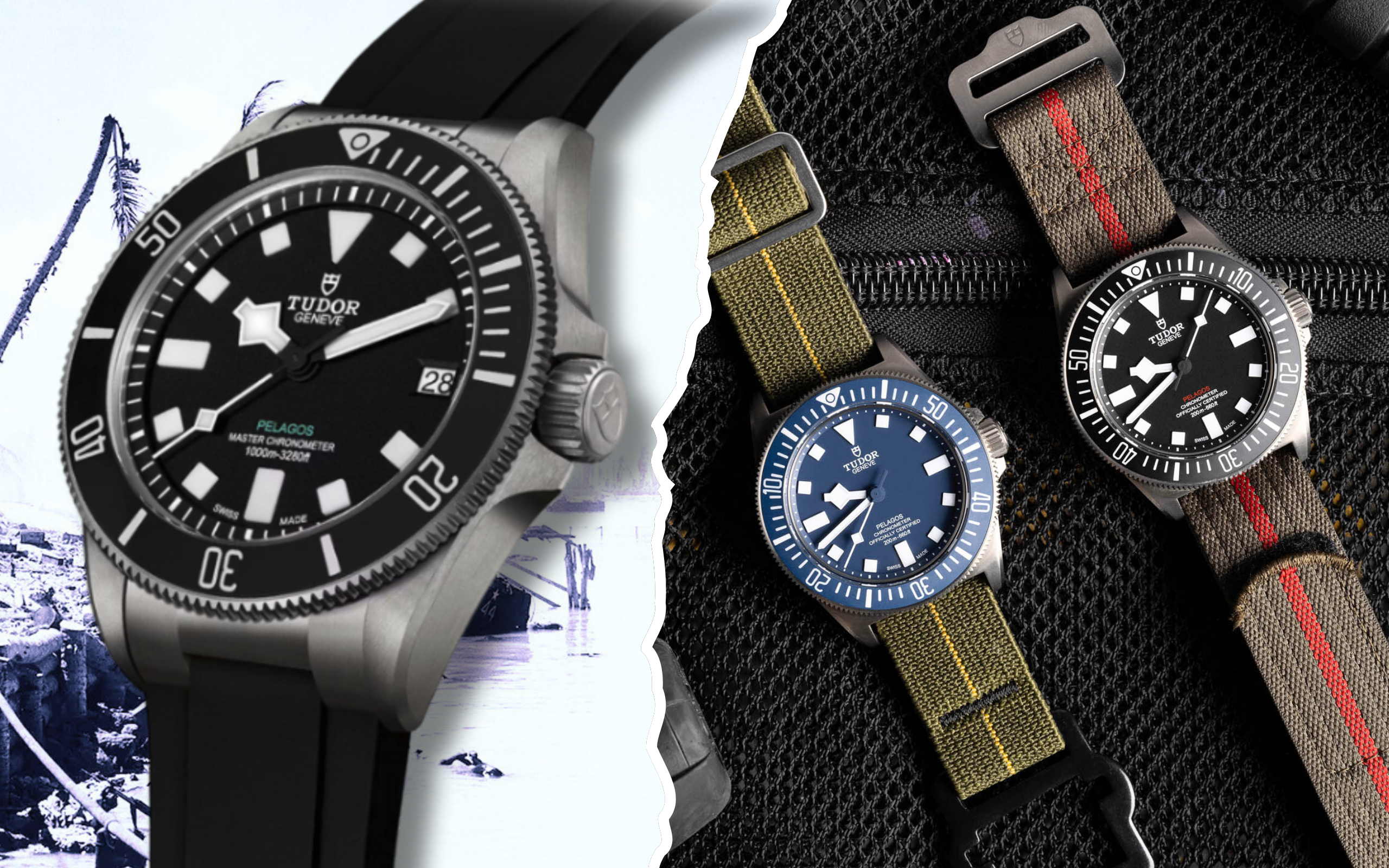
Tudor Cements Its Role As Tool Watch Leader
As The Industry Trends Toward Luxury, Tudor Embraces Its Tool Watch Heritage With Watches and Wonders 2025 Releases Last year, we compiled a list of...
Read OnAs The Industry Trends Toward Luxury, Tudor Embraces Its Tool Watch Heritage With Watches and Wonders 2025 Releases Last year, we compiled a list of Watches and Wonders releases for the W.O.E. community (Read Here), and we planned to do the same thing this year, but the reality is that there aren't many releases that embrace our “Use Your Tools” ethos. In 2025, whether we like it or not, the watch industry has trended toward luxury, precious metals, horologically intriguing complications, and smaller case diameters. Said differently; jewelry. However, even as much of the industry leans away from the utilitarian ethos that serves as an integral part of the culture of our community, one brand continues to carry the proverbial torch: Tudor. This is still the way. While big brother Rolex was unveiling the Land-Dweller, an integrated bracelet “sports” watch starting at $13,900 that feels infinitely more jewel than tool, Tudor’s 2025 collection remained true to the brand’s modern ethos, producing luxurious yet utilitarian watches informed by the brand’s impressive heritage in diving and the military. To be clear, other brands are striking the balance between utility and luxury with certain models situated within broader collections. However, no brand in its price tier is as dedicated to the tool watch as Tudor in 2025. While a horologically significant development and overall cool watch, the Rolex Land-Dweller probably isn’t going to be the next watch trend among the military elite. (Photo Credit: Rolex) This position is no accident. Tudor’s 70-plus-year relationship with the military and adventurers, secure spot within the Rolex organization, thriving modern unit watch program, and willingness to experiment in both design and technology all contribute to making Tudor the tool watch leader of today. Perhaps the best encapsulating demonstration of this is Tudor’s collection of 2025 releases, unveiled last week at Watches and Wonders in Geneva. Tudor’s 2025 New Releases Tudor’s novelties weren’t what anyone expected, but they do speak to the brand’s tool watch focus. (Photo Credit: Tudor Watch) Where IWC led with an expanded Ingenieur offering including a perpetual calendar, Rolex provided the Land-Dweller as well as a green dial for the Sprite GMT, and A. Lange & Söhne unveiled a full “Honeygold” Odysseus, Tudor continued to do what it does, leaning into more adventurous use cases with watches like the Tudor Pelagos Ultra, a 1000-meter-rated diver, a suite of new Black Bays including the new 43mm Black Bay 68, and a white (“opaline”) dial for the Black Bay Pro. Tudor Pelagos Ultra - Because We Can A 1000-meter dive watch isn’t a tool everyone needs, but it feels like a tool. (Photo Credit: Tudor Watch) In our previous look at Tudors of Espionage, we argued that the standard 42mm Pelagos is the apex predator of Tudor’s collection (credit to Jason Heaton for coining the term), which makes the new Pelagos Ultra the apex predator of apex predators. No one needs 1,000 meters of water resistance. Even the deepest diving commercial saturation divers rarely approach 1,000 feet or approximately 300 meters. The Ultra is large by any standard at 43mm and contains a helium escape valve which allows expanding helium atoms to safely escape during a saturation dive’s days-long decompression process without making the watch explode. (Read more about this process HERE.) The blue Pelagos text might not be to everyone’s taste, but we dig it. (Photo Credit: Tudor Watch) Why make a larger, 1000-meter member of the already dense Pelagos family? Because such a tool didn’t already exist in the collection, and Tudor still values the idea of having different tools for specific jobs. Will anyone actually use the Pelagos Ultra for extreme deep-sea diving? Probably not. But the Pelagos Ultra fulfills this use case, whether real or theoretical, like no watch in Tudor’s history, and that's cool. Other features include luminescent material in two colors, a METAS-certified Master Chronometer caliber, and a grade two titanium case and bracelet with a fancy diving extension system complete with a lume plot. While this may be a niche watch that no one asked for, we expect it to resonate with members of our community. Black Bay 68 The larger 43mm Black Bay 68. (Photo Credit: Tudor Watch) Another interesting release from Tudor I never would have predicted was the Black Bay 68, a larger 43mm addition to the pre-existing 37, 39, and 41mm options. Speaking generally, the Black Bay is Tudor’s modern recreation of its earliest “Big Crown” diving watches, but the range has expanded massively since its 2012 introduction to include a chronograph, multiple GMT models, and numerous colors. Why did Tudor go bigger when the entire industry seems to be going smaller? It’s possible Tudor saw a need for a Black Bay for large wrists or simply wanted people to have the option, but the more likely answer is: because Tudor can. In any case, the Black Bay is still one of the best “heritage-inspired” dive watches in its class, and the addition of the larger 68 will only make that argument stronger across a wider range of wrists. The new “Opaline” dial Tudor Black Bay Pro. (Photo Credit: Tudor Watch) There were, of course, several other updates from Tudor, including the addition of a five-link bracelet for the Black Bay Chrono, a new burgundy version of the Black Bay 58 that calls back to a prototype Tudor Submariner, and the welcome addition of a white-ish dial for the Black Bay Pro. I’m not sure any of these watches represented an answer to a specific consumer request, but they do speak to what Tudor is all about, real tool watches at the “entry to luxury” tier. Tudors Of Espionage (T.O.E.) Tudor tool dive watches new and old. (Photo Credit: James Rupley/W.O.E.) As we described in our detailed look at Tudors of Espionage, part of what forms modern Tudor’s DNA is its longstanding associations with militaries including the French Navy or Marine Nationale, the United States Navy, and numerous other military and government organizations. Perhaps the best example of this reverence for the military is the Tudor Pelagos FXD, a watch that was released in 2021 after being developed in close collaboration with the Commando Hubert Combat Swimmers, the French equivalent of the US Navy SEALs. A US Navy EOD Technician wears a Tudor Pelagos FXD during training operations in 2025. (Photo Credit: US Navy) More than slapping a unit logo on an existing watch for marketing’s sake à la Panerai, the FXD wouldn’t exist were a development process for a fixed lug dive watch not put forth by an elite maritime SpecOps unit. Several rounds of prototyping, extensive testing, and real money went into crafting a $4k dive watch that can only be worn on pull-through straps including the hook-and-loop strap that accompanies the FXD. The French Commando Hubert collaborated with Tudor in the development of the Pelagos FXD. An oddity in a world possessed by Submariners and Seamasters, the FXD has become successful in our community because it is two things: a legitimate diving tool watch and a respectable timepiece, powered by an in-house caliber and manufactured in Switzerland with a luxurious level of attention to detail that even watch dorks can get behind. The Shield Protects The Crown (Photo Credit: James Rupley/W.O.E.) Another aspect that allows Tudor to continue to provide more utilitarian options compared to many “luxury” brands is its secure position within the Rolex organization. Tudor’s growth since its global relaunch in 2009 and the release of the Pelagos and Black Bay in 2012 has been explosive, but it’s important to contextualize Tudor within the greater Swiss watch industry. According to the recent report from Morgan Stanley and LuxeConsult, Tudor accounted for only 1% of the Swiss industry’s implied retail market share. Further, from 2023 to 2024, Tudor reportedly recorded a massive 34% decrease in sales, so does this mean Tudor is screwed? While Tudor execs are no doubt concerned, Tudor is also Rolex, the brand claiming the top spot in the Swiss industry and a staggering 34% market share based on turnover eclipsing CHF 10.5B. Tudor exists in the shadows of Rolex in some respects, but that also comes with the security of knowing money ain’t a thing. A down year is a down year, but it’s hard to imagine Tudor pivoting from its core competency, which continues to be utilitarian watches. (Photo Credit: James Rupley/W.O.E.) As we’ve described before, an internal adage within the Rolex organization is that the “Shield Protects the Crown”, but it’s important to remember the Crown is the thing with the gold and the jewels and is ultimately responsible for the bottom line. Tudor’s Modern Unit Watch Program US Secret Service CAT Tudor Pelagos (Photo Credit: James Rupley/W.O.E.) Another aspect demonstrating Tudor’s position on tool watches and celebrating its military associations is the brand’s modern unit watch program, which has grown steadily since its inception several years ago. Tudor’s involvement in unit watches, customized versions of the brand’s standard models produced in small numbers for military units or government organizations, is significant because these programs are almost certainly not a key driver of revenue for a brand Tudor’s size. While other brands have expanded their unit watch programs, we would argue that Tudor is still the leader in this space, having completed unit-specific watches for some of the most elite forces in the United States and Europe, many of which have not been seen in the public. Many of these unit watches would have serious marketing value for Tudor, but the fact that the brand does not advertise or even acknowledge the existence of the program is clear evidence that Tudor is in this space for the right reasons. Tudor & Tool Watches A Tudor unit watch produced for the Diplomatic Security Service. (Photo Credit: James Rupley/W.O.E.) We acknowledge that for most, watches with prices starting around $4,500 (for the standard Black Bay 58) aren’t going to be pushed to the limit in operational settings for either military or intelligence professionals. However, within the context of our community, many do exactly that, balancing the utility presented by their timepieces with a genuine appreciation for horology. For practitioners embodying the Use Your Tools ethos, modern Tudor presents an excellent option, being less expensive than big brother Rolex as well as competitors like Omega while also offering more watchmaking intrigue compared to less expensive brands like Seiko. No matter where the watch industry goes in the future, we believe and hope Tudor will continue to produce tool watches as it has done for the past seven decades. If you enjoyed this article, please consider signing up for our weekly free newsletter for further updates HERE. Read Next: The Dive Watch - Everything You Need To Know
Read On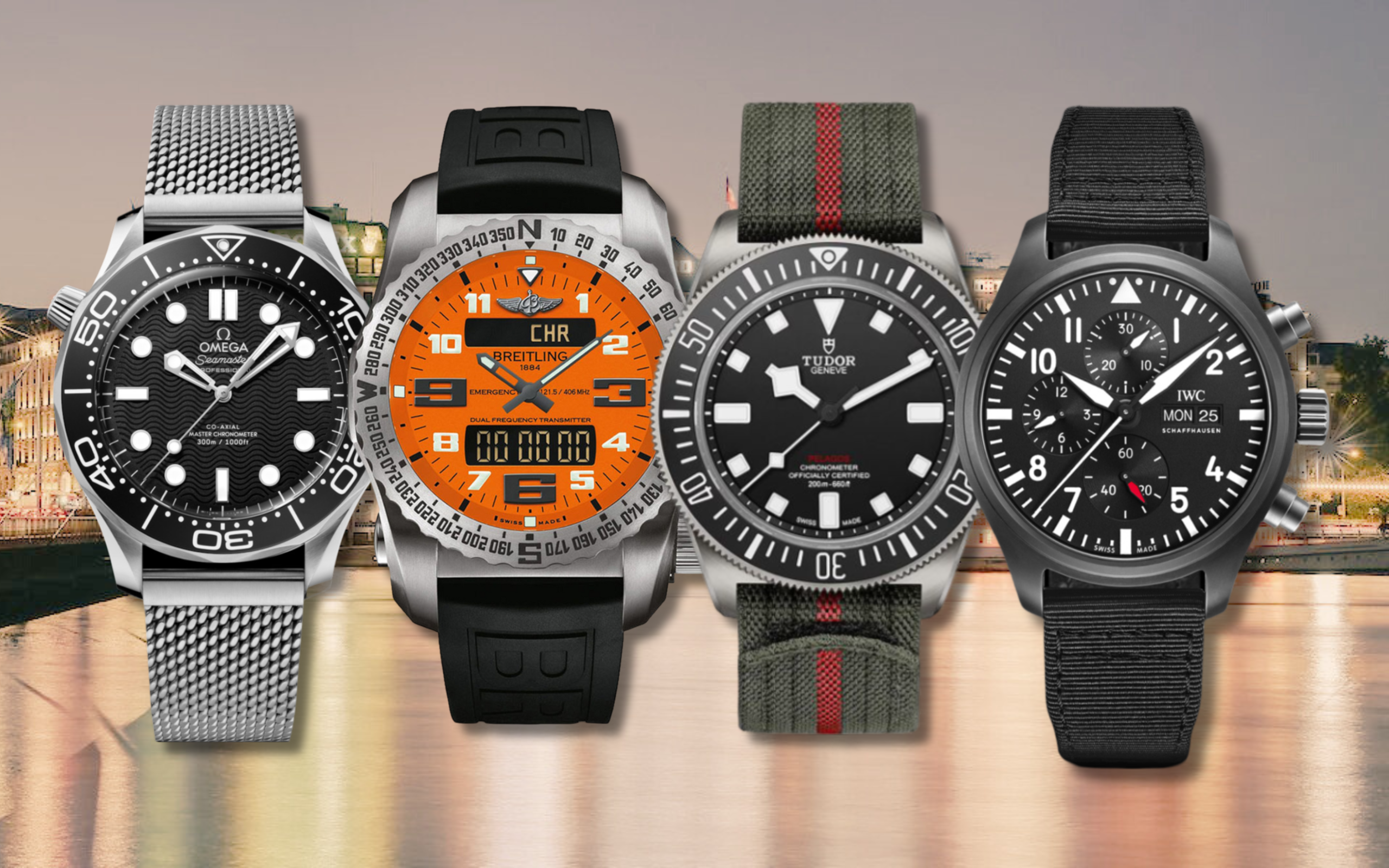
An Inside Look At The Swiss Watch Industry
I Visited Tudor, Omega, IWC, & Breitling - Here Is What I Learned Switzerland is the epicenter of “watches of espionage.” The relationship to watches...
Read OnI Visited Tudor, Omega, IWC, & Breitling - Here Is What I Learned Switzerland is the epicenter of “watches of espionage.” The relationship to watches is obvious. Based on a watchmaking tradition going back centuries, Switzerland is home to the majority of luxury watch brands from Patek Phillipe and Rolex to Tissot and Hublot. The country’s connections to espionage are less understood. A historically neutral country, Switzerland houses several international organizations including the United Nations in Geneva, and is often the location of high-stakes intergovernmental meetings both overt and clandestine. Traditionally loose banking laws have also made Switzerland a convenient place for individuals to store wealth, regardless of the origin of those financial gains. Needless to say, Switzerland is a country that I have visited many times and holds a special place in my heart. W.O.E. at Omega SA in Biel/Bienne, Switzerland The intentions for this trip were simple: to learn more about the Swiss watch industry and specifically brands that are closely aligned with our community. While Omega, Tudor, IWC, and Breitling are very different companies, the one thing they have in common is decades-old relationships with our community. Initially producing purpose-built issued military watches in the 20th century, today these brands are the leaders of modern unit watch programs. IWC’s pilot’s watches, Omega’s Seamasters, Tudor’s extensive dive line, and Breitling's aviation-centric collection are accurately depicted as luxury items today, but they were all once purpose-built tools. “Watches of Espionage” is in the DNA of each of these companies and I would go as far as to say they would not exist or be where they are today without military end users. Breitling manufacturing facility in La Chaux-de-Fonds, Switzerland (W.O.E.) I was fortunate to meet with CEOs, watch designers/watchmakers, suits, and most relevant to W.O.E., the individuals that run each brand’s Unit Watch programs. The experience gave me a deeper appreciation and respect for the craftsmanship and resources it takes to build and sustain a leading watch company. I realize how unique it is to be granted access to these closed-off facilities and this level of openness is not something I take for granted. A Geography Lesson Geneva, Switzerland. Switzerland’s watchmaking industry is intriguing in that it spreads across the relatively small country’s varied geography and its many cultural boundaries. While many of the watch industry’s corporate headquarters are located in Geneva, Switzerland's second-most populous city, the majority of actual production including movements takes place in the Jura mountains spanning the country’s northwestern border. Traditionally, watchmakers expanded to this area to take advantage of an agricultural workforce that was dormant during the winter months, creating the “farmer watchmaker” heritage that many brands tout today. Map of Switzerland’s watchmaking centers. (Credit: Federation Of The Swiss Watch Industry) Swiss watchmaking also spans the country’s language barriers. Rolex/Tudor, which is headquartered in Geneva, is staffed primarily by French-speaking Swiss or French workers traveling across the border, but as you head north toward Biel/Bienne, Omega’s headquarters, language and culture shift to a blend of French and German influence. Breitling is also a brand of two cultures, with Swiss-German origins, a headquarters in German-speaking Grenchen, and a production facility in French-speaking La Chaux-de-Fonds. In contrast, IWC is located in Schaffhausen, near Zürich and just across the border from Germany, conducting nearly all of its business in German. Form Follows Function - Purpose-Built Tools Ander Ugarte (left) and Christian Koop are the head designers for Tudor and IWC, respectively. One of the highlights of the trip was meeting with Christian Koop and Ander Ugarte, the heads of design of IWC and Tudor, respectively. Intensely passionate and masters of their craft, each walked us through the process and attention to detail involved in designing a modern watch for brands steeped in heritage and tradition. The DNA of iconic watches like the IWC Mark series and Tudor dive watches can be traced back to the divers and soldiers who wore them over half a century ago. While today’s watches trend to luxury items vs real tools, a common phrase I heard was “form follows function.” The watches are still designed with the end user in mind, just as they were a century ago. Automation vs. Hand-Crafted Modern watchmaking is a fascinating blend of cutting-edge technology and centuries-old hand craftsmanship. The two most surprising aspects of visiting the manufacturing facilities of Breitling, Omega, and IWC were the number of robots/automated steps in contrast with the number of steps still requiring human touch. The manufacturing facilities are reliant on technicians and watchmakers from the rural areas of Switzerland, who still work farmers' hours, just as they did centuries ago. Breitling watch technician. Each morning, hundreds of watchmakers and technicians arrive at the facilities, don sterile antistatic white coats and clean Crocs or Birkenstocks, and spend hours tightening tiny screws to spec or attaching dials to movements. It is a painstaking process and a truly remarkable juxtaposition of futuristic cutting-edge technology and traditional watchmaking. Trying my hand at watchmaking at IWC Schaffhausen. The result is a watch containing hundreds of components, all working in sync to tell you the time. The watches are then shipped around the world through complex dealer networks and intermediaries for you to purchase. Seeing this process firsthand is a remarkable experience and gives me a greater appreciation for the technical and logistical prowess required in Swiss watchmaking. Military Unit Watch Programs - Omega, Tudor, IWC, & Breitling A “Unit Watch” is a timepiece that is customized by the manufacturer for members of a specific unit or organization. Customizations can include the unit’s insignia on the dial and/or an engraving on the caseback. When it comes to Swiss watches, Tudor, Omega, and IWC are the modern leaders in the space and we have profiled each program in past articles. An Omega Seamaster “Unit Watch” produced for the US Navy SEALs. (Photo Credit: James Rupley/W.O.E.) A cynical analysis of these programs would conclude they are sophisticated marketing initiatives, meant to garner publicity through leaks on social media. While I would argue they accomplish this goal in certain instances, the reality is the brands are largely hesitant to publicly acknowledge the partnerships. Swiss brands have spent decades carefully curating a specific narrative to position themselves as aspirational luxury goods. “Tudors of Espionage,” “Sketchy dudes wear Breitling”, and an iconic image of Omega Seamaster on the wrist of a Secret Service agent after an assassination attempt run counter to these carefully crafted narratives. Diplomatic Security Tudor Black Bay 58. Further, in contrast to smaller brands like Bremont which garner significant revenue from military programs, for the large Swiss houses, it is costly to divert resources to customizing a dial or caseback for a relatively small batch of custom watches, which are also often sold at a discount. In short, these programs likely aren't big money makers for brands that measure watch sales in the hundreds of thousands of units. IWC Unit Watch for AH-64 pilots. So why do large luxury watch brands bother with Unit Watches? As far as I can tell, these programs are passion projects for individuals within each company and they are somewhat controversial for some brands. I have spent significant time with the individuals in charge of the unit watch programs and they are fiercely passionate about them. They truly believe that they are serving a greater calling by producing meaningful tools and heirlooms for our community. Not surprisingly, these individuals also appreciate what we are doing at Watches of Espionage. Watch Brands Are Businesses This one is so obvious that it shouldn't have to be said, but it's a simple fact that many watch “enthusiasts” often forget. The purpose of a watch company is not to make watches, it's to make money. Many of the individuals who work at the major brands are suits, marketing professionals, and technicians who could work for any number of companies in the luxury goods space. While some of them are passionate about watches, the majority of them likely do not consume watch content on their personal time and are not “watch nerds.” Swatch Group Headquarters, left is Omega building. (Photo CreditL Stefan Wermuth/Bloomberg) To be clear, while I enjoy making fun of suits as much as the next guy, this is actually a good thing. If you love watches like I do, then you should want watch brands to succeed… at making money. Headwinds for the watch industry are at an all-time high with Apple Watch sales surpassing the entire Swiss watch industry. It’s not a foregone conclusion that the most iconic brands like Rolex, Patek Phillipe, and Audemars Piguet will be around in 2074. For the most part, modern watches are luxury goods, meaning they are unnecessary. If they are not profitable, they will disappear. Watch nerds often shed crocodile tears on internet forums complaining about why brand X doesn't produce a specific watch or “listen to the community,” but the reality is brands generally make decisions based on mass market appeal. It may be a tough pill to swallow, but many brands do not care about enthusiasts, and from a bottom-line perspective, they shouldn’t. Ownership Matters As consumers, we often think of brands as discrete monoliths, independent entities that make design and product decisions in a vacuum. However, industry consolidation has led to four conglomerates owning the majority of the Swiss watch industry; Swatch Group, Richemont, LVMH, and the Hans Wilsdorf Foundation, the parent organization for Rolex and Tudor. Somewhat dated graphic showing ownership in the watch industry (Image Credit: Tony Traina, Rescapement) While in theory, the brands are independent or semi-independent entities, the reality is that Omega's decisions could impact the overall standing and profitability of Swatch Group as a whole, and IWC is just one node of the broader Richemont family. While Tudor often paints itself as an independent entity, when I visited Tudor HQS in Geneva, it was inside Rolex. It’s naive to think that there is no coordination between the companies. Breitling was purchased from the Schneider family by a private equity company in 2017 and whether we like it or not, the overall decisions of the brand are impacted by this ownership structure. (Photo Credit: Rolex) Conglomerates are a double-edged sword. On one hand, they offer access to capital and resources, Richemont and Swatch Group are multibillion-dollar conglomerates with robust infrastructure and supply chains. On the other hand, the conglomerates must ensure each company works towards the same goal, which likely limits independence and creativity at the brand level. Coopetition - Competitors Or Partners? Further, even between competing brands, there is a level of cooperation and sharing. Historically, the legendary Rolex Daytona utilized a chronograph movement supplied by Zenith. Even today, Breitling and Tudor, theoretically arch rivals, share movements, with Breitling utilizing several of Tudor’s base automatic calibers and Tudor receiving a modified version of the B01 chronograph caliber in return, a level of cooperation you aren’t going to see from Apple and Samsung. Tudor's MT5612 is produced by Tudor and voluntarily shared with Breitling, a rival watchmaker. (Photo Credit: Monochrome Watches) While they’re never going to admit it publicly, many of the biggest brands also look to the same suppliers for specific components from jewels to mainsprings to cases and bracelets to construct their “in-house” movements and complete watches. Third-party certifications like COSC and METAS are also utilized by multiple brands looking for a competitive advantage. Despite being fundamentally in competition, I heard several brand leaders admit the overall health of the Swiss watch industry is always in mind. A rising tide lifts all ships. For the industry to succeed holistically, the brands must balance being fiercely competitive with a measured level of cooperation. While it was created in collaboration with Omega and an impartial third party, Tudor has also started instituting METAS testing and certification for some of its watches. (Photo Credit: Monochrome Watches) Tribalism Exists at Every Level Visit any social media watch page and the tribalism—visceral feelings for or against a specific brand—is evident. There are fewer general “watch guys” and more “Rolex” or “Omega” guys. The passion is real and watch nerds think their brand is the best and everyone else sucks. The individuals I met at each brand were fiercely proud of the product they produce, which is cool to see. While they were professional enough to not bad mouth another company outright, it's clear that they truly believed their brand was the pinnacle of modern watchmaking. While this may sound like a negative, this intense conviction to be the best was inspiring. If I buy a Tudor, Omega, Breitling, or IWC, I like knowing that the people making it in the mountains of Switzerland are true believers. Heritage Matters Omega museum, Biel/Bienne, Switzerland When you buy a watch, you are not just buying the components, you are buying a piece of history. One of the most educational aspects of the trip was visiting the museums of Breitling in Zurich, Omega in Biel/Bienne, and IWC in Schaffhausen. For the brands I visited, the history is rich and compelling, and on full display. Breitling Emergency Prototype (Breilting Museum, Zurich Switzerland) Of course, the brands emphasize certain periods and events to carefully curate a narrative, but they are still compelling because it’s authentic. Omega’s museum had numerous watches worn by astronauts, soldiers, and spies, both real and contrived (Bond, James Bond). IWC was founded by an American soldier, Florentine Ariosto Jones who fought for the 13th Massachusetts Infantry Regiment during the Civil War and would go on to produce watches for both the Allies and the Germans during World War II, something the museum refreshingly does not gloss over. Breitling’s DNA is rooted in aviation, having provided issued watches during both World Wars decades before becoming a go-to option for those operating on the fringe of sketchiness in the 1990s and 2000s. These museums are open to the public, and I encourage you to visit if you find yourself in Switzerland. The great thing about the country is you can get pretty much anywhere in a few hour train ride. Left is an issued “MN” Tudor MilSub on an original strap, fashioned from parachute webbing. The one on the right was a unit purchase gift for a retiring officer. It was purchased through the MN Rolex-certified watchmaker, Yves Pastre who had a workshop in Toulon. (Photo Credit: Tudor Archives/W.O.E.) Unfortunately, Tudor does not have a museum, but they did provide us access to their extensive archives of military-issued watches and prototypes. This will be the subject of a future Dispatch and the spice level was high. Swiss Watch Marketing is Antiquated I have written in the past about the sophisticated marketing machines behind the Swiss watch industry and this trip confirmed that thesis (Read Here). The major brands, including IWC, Tudor, Omega, and Breitling, have masterfully curated a narrative based on decades-old craftsmanship and history, that makes them leaders in a crowded industry. In addition to co-opting watch media, they spend millions of dollars a year sponsoring sporting events, recruiting celebrity ambassadors, and producing slick marketing material. Watches and Wonders, an international watch and jewelry industry organized by the Watches and Wonders Geneva Foundation. (Photo Credit: Wikicommons) While I am by no means a marketing expert, I am intimately familiar with human nature. I get the feeling that the brands are reliant on what has worked in the past and not focused on the future, or for that matter the present. Celebrity ambassadors, event sponsorship, film product placement, and heavily-curated “new releases” are masterclasses in Marketing 101 but the modern consumer is savvy and the media landscape has changed. Legacy watch publications have declined in recent years and have been replaced by a plethora of dispersed voices. There are TikTokers, Youtubers, and podcast hosts who are more influential than Tom Brady and even James Bond. The Swiss watch industry appears slow to adapt to the new landscape and continues to fall back on tried and true methods. Given its age, watchmaking as a whole is steeped in tradition and slow to adapt, especially when it comes to reaching the younger consumers the industry so desperately needs to continue. W.O.E. in Schaffhausen, wearing the same IWC Mark XVII I wore while operational at CIA. Does visiting a facility impact how I will cover them? To date, we have kept the traditional watch industry at arm's length distance, something that frankly much of the industry is okay with. That said, as we have grown our audience we owe it to our community to present thoughtful and unbiased commentary on the watches and brands that are aligned with our ethos. I made some great friends and contacts on this trip and am grateful for the level of access I was granted. It will continue to be a balance between nurturing these relationships and remaining unswayed by the influence of the brands on content. Despite some of the critiques above, my appreciation for the Swiss watch industry in general and these legendary brands in particular could not be higher. I am grateful for those individuals who made this trip possible and thankful for the time and effort of the teams in Switzerland. There are several threads to pull on from this trip and we plan to write additional stories on IWC’s “Top Gun” unit watch program, recent developments in Omega’s unit watch offerings, and the real story behind the Tudor FXD. Thank you all for the support, more to come. -W.O.E. *Note, as with all of our content, this is not sponsored by Tudor, Omega, IWC, Breitling, or any other brand. If you enjoyed this article, please consider signing up for our weekly free newsletter for further updates HERE. Read Next: W.O.E. 2024 Holiday Gift Guide - Top Picks From Other Brands
Read On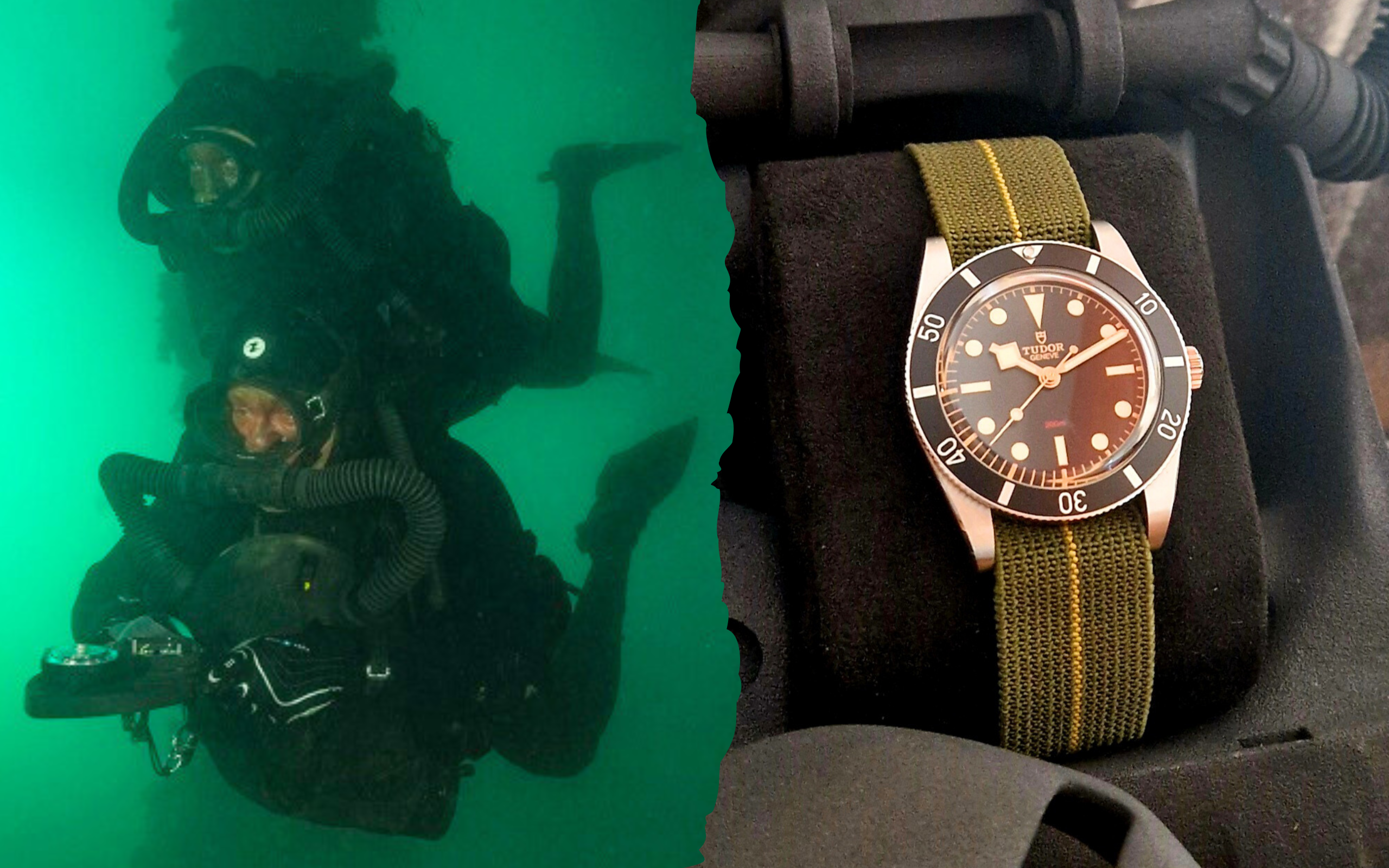
The Commando Hubert Tudor Black Bay 54 & The Heritage Commando Strap
A Watch & Strap Commemorating The 100th Training Class For France’s Elite Maritime SpecOps Unit Though military-issued timepieces and privately-purchased watches worn during military or...
Read OnA Watch & Strap Commemorating The 100th Training Class For France’s Elite Maritime SpecOps Unit Though military-issued timepieces and privately-purchased watches worn during military or government service are significant to our community, the concept of a customized “Unit Watch” presents one of the single best examples of how watches are ingrained in the culture of the military, SpecOps, and the world of intelligence. There are other important players in the modern unit watch landscape, but Tudors of Espionage (T.O.E.) will always occupy a special place in our hearts. From the Shield’s historic connections to US Navy SEALs in the Vietnam War to the modern US Secret Service Counter Assault Team and multiple Tier One SpecOps units, Tudor’s roots within our community run as deep as any. Among Tudor’s earliest forays into military service is the brand’s relationship with the Marine Nationale or French Navy, a partnership born in the 1950s that laid the groundwork for the modern Pelagos FXD in 2021. In this Dispatch, our friend Ross Povey, a dedicated Tudor expert and the founder of Tudor Collector, shares the intriguing story of the second modern Tudor commissioned for the French Navy’s elite maritime commandos. By Ross Povey The world of military timepieces is enriched by stories of watches that need to have durability, precision, and often distinctive design elements. Whether at the direction of the specific defence department or the requirements of the personnel using them, these watches often have unique attributes that set them apart from civilian examples. And it’s this aspect that drives collectors to acquire such timepieces and chase examples that have been developed and used by the military. Tudor’s relationship with the Commando Hubert dates back to the 1950s, with this image of a Commando Hubert operator and their Tudor Sub coming from 1977. Tudor has a track record of working closely with military forces around the world and no other example is more widely recognised than its partnership with the French National Navy, the Marine Nationale, or MN as it is known. The genesis of the Pelagos FXD lies within this partnership and it is a relationship that dates back to the 1950s. Aside from the publicly available Pelagos FXD and the new FXD GMT MN editions, there has recently been another special “unit watch” commissioned by Commando Hubert to commemorate the 100th Combat Swimmer Course that concluded this summer. The Tudor Black Bay 54 was designed to commemorate the 100th combat diver’s course for the Commando Hubert. The watch is a custom Black Bay 54 with “200m” text on the dial and it marks another significant chapter in this storied history. This special edition watch honours the significant milestone of the 100th Combat Swimmer Course hosted and led by the French diving school, the course is a prerequisite for an operator to be assigned to Commando Hubert. This watch also gave birth to a unique accessory; a unique version of the W.O.E.-ZA Commando Strap crafted from vintage parachute material. 100th Combat Swimmer Course The graduation ceremony following the 100th Combat Swimmer Course. (Photo Credit: Marine Nationale) The Combat Swimmer Course (CNC) is a rigorous 27-week training regimen that prepares France's elite naval commandos for complex operations across various environments. Conducted under the supervision of a lieutenant and ten petty officer instructors, the CNC encompasses three intensive phases, focusing on oxygen diving, preparation for combat swimmer attacks, and specialized combat swimmer skills. The program challenges candidates with deep-sea navigation, underwater demolition, and high-risk parachuting, concluding with a demanding set of exams to test their mastery of these complex disciplines. Only 5 to 10% of those who start the CNC earn the combat swimmer certificate, a testament to the course's difficulty and the high standards expected of participants. This badge of honour signifies more than just successful completion; it denotes a profound journey of personal and professional growth, marking its bearers as exceptional warriors capable of adapting to and controlling aquatic, terrestrial, and aerial environments. This elite training ensures that graduates are not only skilled in advanced military techniques but also equipped to lead and excel in high-stakes missions worldwide. The Black Bay 54 Unit Watch The standard production Black Bay 54 calls back to Tudor’s earliest dive watches. Released in 2023, Tudor revisited its origins with the Black Bay 54, a homage to the brand's first Submariner from 1954. The watch features a historically accurate bezel insert and a tweak to the hands, presenting a watch that's true to its dive watch heritage. With a number of striking similarities to the Submariner reference 7922 with a 37mm no-crown-guard case and water resistance up to 100 meters, the Black Bay 54 maintains these classic proportions while incorporating the modern Tudor manufacture movement, calibre MT5400, and enhancing water resistance to 200 meters. Unlike the standard Tudor models available through official retailers, the Black Bay 54 designed for Commando Hubert includes unique elements that I can share here exclusively. The watch dial, uncluttered by the usual depth ratings and certifications, features a streamlined aesthetic with just a bold red "200m" marking, omitting the typical chronometer certification texts for a no-nonsense military vibe. Furthermore, the dial is marked with "CNC xxx-100" at the bottom, signifying "Cours des Nageurs de Combat" and linking each watch to one of the 100 combat divers’ courses, creating a direct line to the historical courses taught by Commando Hubert. The Heritage Edition Commando Strap (Photo Credit: Z.A. Straps) To accompany the special edition Black Bay 54, Commando Hubert wanted a special strap, which led to the collaboration with my friends at Watches of Espionage and Z.A. Straps. As I’ve written about before, the straps delivered to accompany the commemorative Black Bay 54 were made from a new-old-stock roll of original parachute webbing. This strap not only provides a robust and practical fit for diving and military operations but also carries the essence of history in its fibres. To complete the set, each watch and strap came in a miniature FROGS (Full Range Oxygen Gas System) as a watch box. The collaboration began when Commando Hubert divers expressed the need for a durable strap that resonated with the heritage of Marine Nationale divers. These elite divers historically crafted makeshift straps from parachute webbing for their Tudor MilSubs. The result of extensive prototyping and feedback from the divers led to the creation of two versions of the Commando Strap: a regular production version made from bespoke elastic webbing and the Heritage edition made from vintage material. (Photo Credit: Z.A. Straps) Each strap is fitted with a metal buckle system that has been in use by the Marine Nationale since the 1950s. Used for a number of applications, it was used by Commando Hubert for diving weight belts. The tension makes it very hard to release the system by mistake, but if one decides to ditch some weight in order to surface, it can be done one-handed in a “finger snap”. A Tribute to the Legacy The completion of the 100th Combat Swimmer Course (CNC) by Commando Hubert is not only a milestone for the French Navy but also a celebration of endurance, skill, and the spirit of the elite naval commandos. To commemorate this landmark, we have the special Black Bay 54 that was presented on Heritage Commando Strap, made from vintage parachute webbing. (Photo Credit: Z.A. Straps) It’s unclear whether the French operators will utilize the special edition Black Bay 54 operationally or view them as commemorative timepieces honoring the unit’s history, but we do know the Commando Hubert wear and use their special two-line FXD models in diving contexts, even forgoing the use of a diving computer in many combat swimming scenarios. In any case, the addition of the 100th CNC Black Bay 54 into the annals of Tudor’s already extensive history with maritime special operations is further evidence of the strong link between timepieces and special operations. As W.O.E. often says, the Use Your Tools ethos is alive and well. If you enjoyed this article, please consider signing up for our weekly free newsletter for further updates HERE. Read Next: French SpecOps, Tudor FXD, & The Commando Strap About The Author: Ross Povey, the founder of TudorCollector.com is regarded as the world’s leading expert on vintage Tudor watches. Although an expert on Rolex and Tudor watches primarily, Ross’s work covers the entire field of horology. He writes for and has contributed to some of the most influential publications, including Revolution, The Telegraph, GQ, Forbes, The Rake, Wristcheck, Watch Pro, Watchonista, Hodinkee, QP and is the co-author of the book Daytona Perpetual, a celebration of the automatic Rolex Daytona released through Pucci Papaleo Editore. Ross is Communications Director for Monaco Legend Group auction house and is also an international speaker, regularly hosting watch events in the UK and globally.
Read On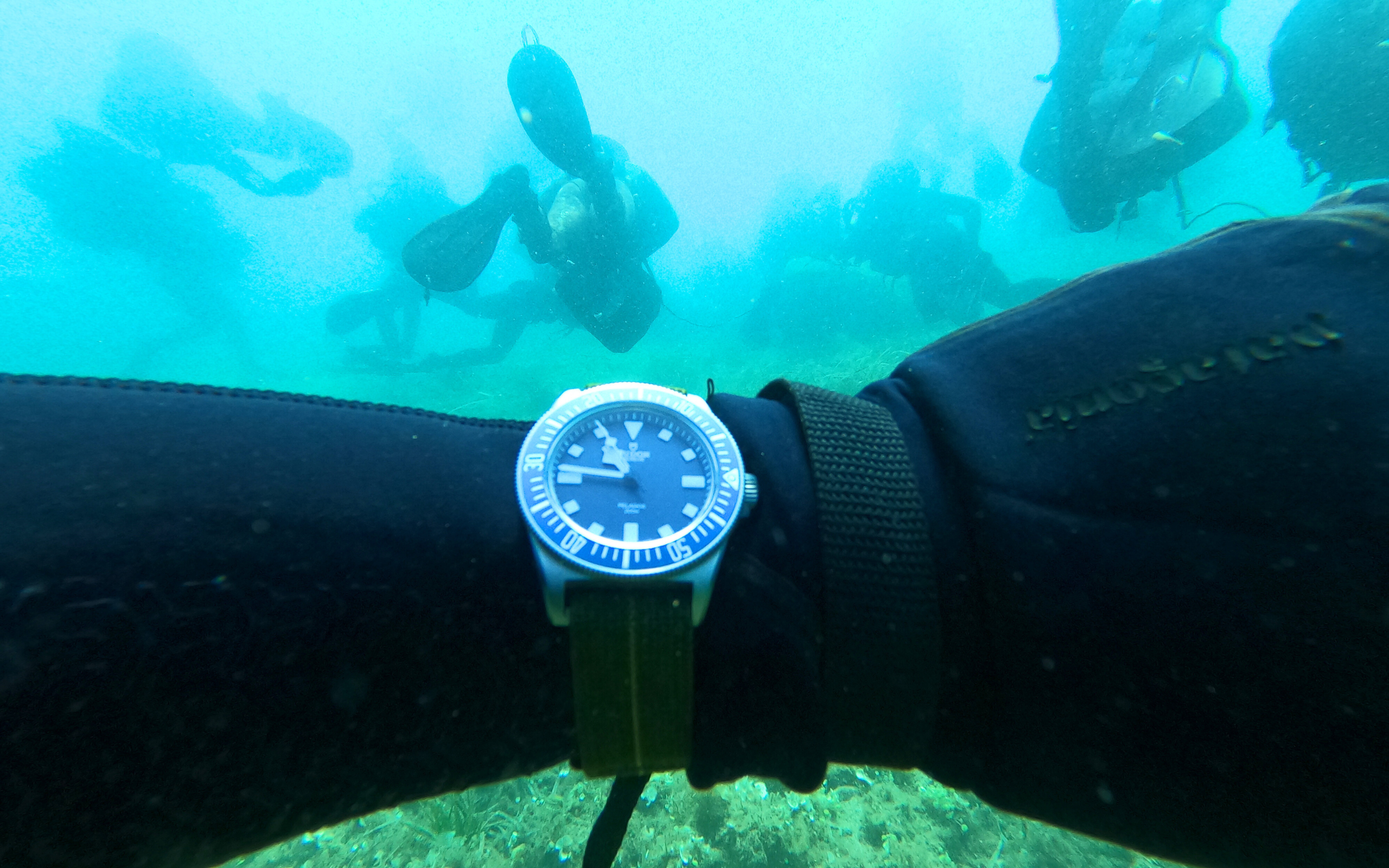
French SpecOps, Tudor FXD, & The Commando Strap
How Z.A. Straps & W.O.E. Developed A Strap For The Commando Hubert’s Tudor Unit Watches In the Watches of Espionage space, the Tudor Pelagos FXD...
Read OnHow Z.A. Straps & W.O.E. Developed A Strap For The Commando Hubert’s Tudor Unit Watches In the Watches of Espionage space, the Tudor Pelagos FXD reigns supreme as the apex predator of dive watches. Developed in partnership with the Commando Hubert Combat Swimmers, the French equivalent to the US Navy SEALs, the FXD is an unapologetic tool watch with legible snowflake hands, a purpose-designed bezel, and fixed lugs. We have discussed Tudor’s extensive relationship with the military and intelligence community and the FXD is the latest example of the over seven-decade-long partnership. A Commando Hubert operator tests a prototype of the Commando Strap on a training dive. The Commando Strap Earlier this year we were approached by an intermediary with a unique requirement: the French Commando Hubert Combat Swimmers wanted to design a strap for their FXDs. The request was simple. The operators required a practical dive strap that honored the legacy of the past, when the French Navy used parachute webbing to fashion in-field made straps for their Tudor MilSubs. The elastic strap would be used in the field and underwater on their “two line” Pelagos FXDs, as well as a commemorative watch that remains confidential. We immediately said yes and called our friends at Z.A. Straps in the United Kingdom when we set about prototyping and field testing the strap based on feedback and requirements from the Combat Swimmers. The result is The Commando Strap, a sterile strap constructed with UK-produced elastic webbing and a unique French Rapco buckle system specifically requested by the operators. With Commando Hubert’s support, we are pleased to offer a version of this strap to the community, which is available HERE. A Tudor Pelagos FXD on a prototype Commando Strap made from vintage parachute elastic webbing. (Photo Credit: Z.A. Straps) The Marine Nationale & Tudor Partnership - A History Lesson In our community, heritage matters. The Commando Hubert Strap is heavily inspired by the longstanding relationship between Tudor and the French Navy, known as the Marine Nationale. This partnership, officially announced on May 4th, 2021 with the launch of the Pelagos FXD, celebrated nearly seven decades of collaboration. The origins of this relationship date back to 1956 when Tudor first supplied the Submariners to the Marine Nationale for field testing by their elite divers. These early watches, including the famed references 7922 and 7923, were lauded for their precision and water resistance. Over the next few decades, Tudor continually refined its designs to meet the exacting standards of naval operations. Notably, in 1958, the introduction of the reference 7924, or "Big Crown," marked a significant advancement with its new case and enhanced water resistance up to 200 meters. The evolution continued with the 7928 model, which introduced protective shoulders around the crown, a critical design enhancement for underwater activities. A Marine Nationale diver wearing a "Big Crown" Submariner in the late 1950s. The adaptation reached a pinnacle in the late 1960s with the debut of the "Snowflake" Submariners, designed specifically for improved visibility in murky underwater environments. These models featured Snowflake hands and later “Mercedes” hands and continued to be issued through various iterations until the mid-1990s. They have become both collectible and iconic in the world of dive and military watches. Marine Nationale Pelagos FXD “Two-Line” Pelagos FXD on a special dive strap used to connect swimming pairs. The original blue Pelagos FXD was developed in partnership with the French Commando Hubert, featuring a bidirectional countdown bezel, strap slots cut into the titanium case, and a specialized dive strap with a D-ring to connect swimming pairs. The blue dial and bezel were practical choices for underwater visibility but also a nod to the blue snowflake Marine Nationale-issued watches of the 1970s. The main difference between the civilian and French SOF versions is the limited “two line” text on the dial of the unit versions and the unit versions are available in an LHD, or left-hand drive format. Of note, these watches are not issued, but purchased by each operator individually. Commando Hubert Marine Nationale FXD paired with a Commando strap prototype. To mark the 100th graduation of the French Navy’s Diving School, Commando Hubert commissioned 100 Tudor watches outfitted with a special version of the Commando Strap produced using vintage material. Each of these straps is crafted from historical new old stock parachute webbing and presented in a box designed to mimic the look of a rebreather unit, paying homage to the diving equipment used by the Marine Nationale both then and now. Development Of The Commando Strap The Commando Strap utilizes a reproduction webbing and a special quick-release buckle made in France. (Photo Credit: James Rupley/W.O.E.) The unit expressed a need for a durable strap that incorporated a robust buckle system capable of quick release, crucial for the high-stakes scenarios faced by navy divers. A French-made buckle leveraged for other gear items by French SOF became central to the design. Used in a number of applications by French SOF, these buckles were the perfect utilitarian way to fasten the new straps while offering quick-release functionality. The buckles, sourced directly from France as directed by the Commanding Officer of Commando Hubert, are very secure and have been tried and tested for many years in arduous environments. They are extremely dependable but will chip and patina with use, creating a unique and worn look. The open gate slider buckle that allows the Commando Strap to be used with fixed lugs was also sourced from the UK and executed in stainless steel at the Commando Hubert’s request. The Commando Hubert requested we source a specific French-made buckle familiar to the unit from their load-bearing equipment. The development process involved extensive prototyping to ensure the strap could be seamlessly affixed to watches with fixed lug bars, such as the Pelagos FXD, and adjustable so that they can be extended to fit over wetsuits for operations and training. The Commando Strap was rigorously field-tested by divers in extreme conditions to guarantee its long-term performance. Similar to the vintage straps used by the Marine Nationale, the Commando Strap is 21mm in width, capable of working well with both 20mm and 22mm lugs as well as fixed lugs without looking out of place. 21mm is the width of the traditional parachute straps. A diver from the Commando Hubert tests a prototype of the Commando Strap on his two-line Tudor Pelagos FXD. Aesthetic Appeal The Commando strap features elastic parachute webbing paired with French-made buckles, joined in a design that is both historically rich and functionally superior. The strap’s registered design system allows for easy adjustment and secure fastening, crucial for maintaining performance in the unpredictable environments encountered by military divers. The aesthetic of the strap complements the rugged functionality with a nod to its historical origins. Two versions of the strap were made, one with vintage French Navy parachute webbing and a reproduction version using new custom elastic webbing produced in the UK. The Commando Strap available now is constructed with reproduction webbing while a highly-limited drop utilizing vintage French parachute webbing will be announced at a later date. A diver from the Commando Hubert during prototyping for the Commando Strap. The webbing for the regular production straps was replicated meticulously by Darren at Z.A. Straps in collaboration with a UK-based mill, ensuring that each piece is a faithful homage to the original material used by the French Navy. A Rich Legacy The Commando Hubert Strap is set to become a true collectible item among collectors and enthusiasts alike, bridging the gap between the past and the present, and forging a new chapter in the storied history of military use of wristwatches. Beyond its historical value, the strap is an embodiment of the “Use Your Tools” ethos, designed from the ground up in collaboration with elite military divers to create a useful tool to pair with any capable watch. The Commando Strap is made from UK-made reproduction webbing. (Photo Credit: James Rupley/W.O.E.) The Commando Strap is more than an accessory—it is a piece of history crafted into a form that meets the modern-day demands of navy divers. As this strap wraps around the wrists of today's adventurers, it carries with it the legacy of innovation, a spirit of endurance, and a continuous commitment to excellence. This strap is not just a part of a watch; it is a vital instrument for those who believe in using their tools and honoring the legacy of those who came before us. BUY HERE: Z.A. Straps x W.O.E. Commando Strap If you enjoyed this article, please consider signing up for our weekly free newsletter for further updates HERE.
Read On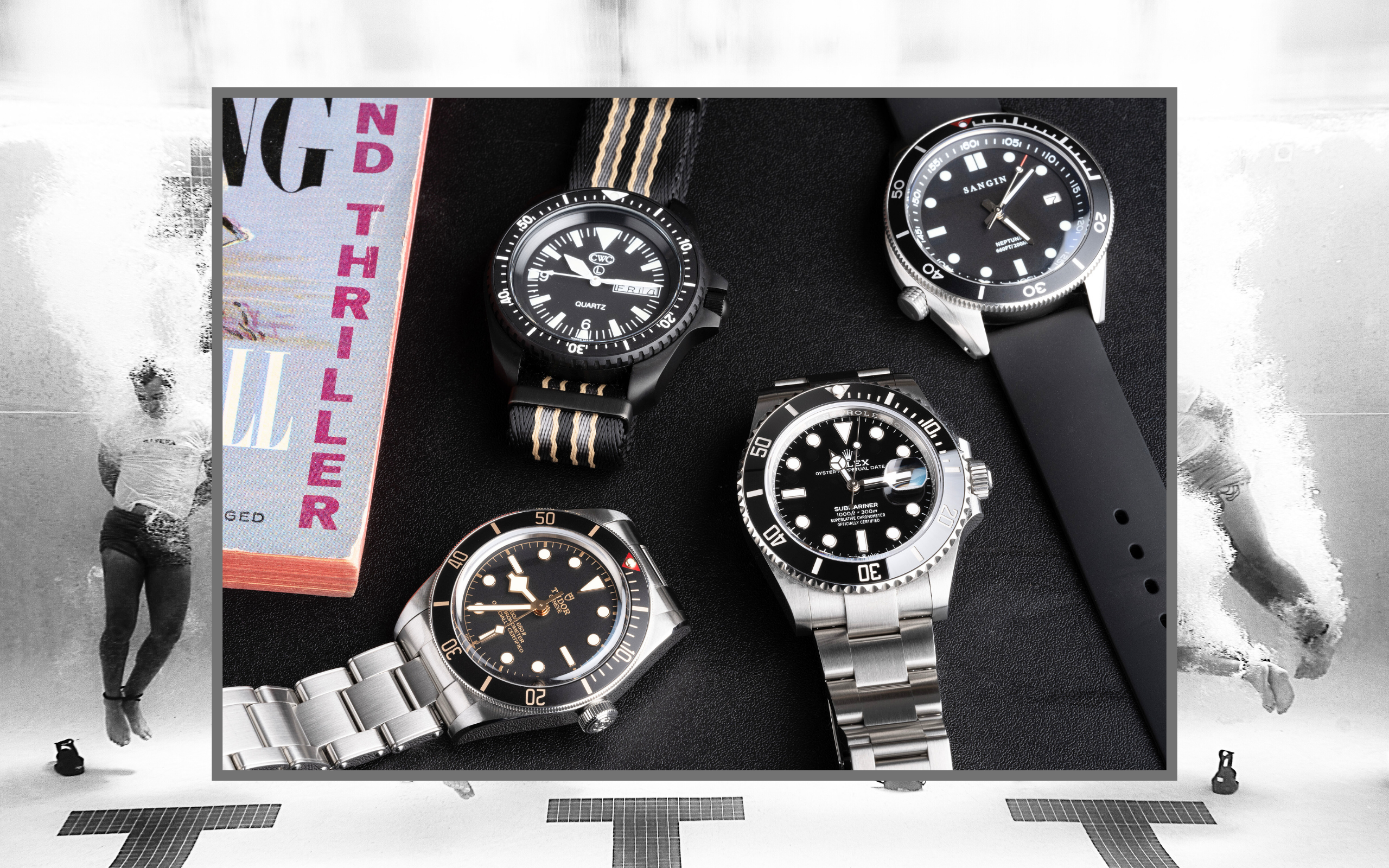
The Dive Watch - Everything You Need To Know
Going In-Depth With History’s Most Popular & Impactful Tool Watch Despite the relative lack of popularity of scuba diving, the dive watch prevails as one...
Read OnGoing In-Depth With History’s Most Popular & Impactful Tool Watch Despite the relative lack of popularity of scuba diving, the dive watch prevails as one of the most popular categories in watchmaking while also claiming several of history’s most recognizable designs including the Rolex Submariner, Omega Seamaster, and Blancpain Fifty Fathoms. Watches intended for diving have also been worn by a variety of sketchy individuals at the forefront of history-shaping events including the pioneering Panerai models utilized by the commando frogmen of the Italian Decima Flottiglia MAS in WWII, Doxa Subs on the wrists of Jacques Cousteau and his team as they pioneered underwater filmmaking, and even a modern Rolex Submariner worn by a US Navy SEAL on the raid that killed Usama bin Laden back in 2011. (Photo Credit: W.O.E./James Rupley) What Is A Dive Watch? With all of that being said, we all have a general idea of what a dive watch is and does, but what exactly constitutes a dive watch? Which functions, formats, or capabilities are essential, and which are marketing fluff? In this Dispatch, backed by my experience as a commercial diver and professional watch nerd, we’ll go in-depth with the anatomy of a dive watch, presenting the key elements that add up to a competent dive timer whether or not you intend to use the watch for its intended purpose. An elapsed time bezel is also great for grilling steaks. What Is Water Resistance? In 2019, a custom Omega Ultra Deep descended to Challenger Deep, the ocean’s deepest point, strapped to the outside of Victor Vescovo’s submersible, Limiting Factor. (Photo Credit: Omega) Let’s get the obvious out of the way. A dive watch is only as good as its ability to resist the sometimes massive pressures and constant risk of flooding encountered in the undersea environment. Most dive watches achieve their water resistance with screwed sealing surfaces and gaskets which are necessary because the pressure at depth can be enormous. For every foot of depth encountered by a watch in seawater, .445 pounds of pressure is applied per square inch. Divers are historically bad at math so the equation for calculating pressure on the fly is typically expressed as “half the depth” meaning that if you’re diving to a relatively pedestrian 100 feet, your watch will encounter approximately 50 (or exactly 44.5) pounds per square inch of pressure, enough to make the water really want to get inside your watch. The deeper you go, the tougher it gets for your watch’s tender insides to stay dry. Therefore, the vast majority of watches intended for diving are rated to at least 200 meters, but many are rated to more extreme depths including 3,900 meters (12,800 feet) for the Rolex Deepsea or an even more obnoxious 6,000 meters (20,000 feet) for the Omega Planet Ocean Ultra Deep. A 100-meter-rated watch like the Casio AE1200WH World Time is typically fine for casual scuba diving. (Photo Credit: Benjamin Lowry) Can I Wear My Watch Underwater? While we’re here, let’s quickly dispel a couple of common myths. I wouldn’t take a 30 or 50-meter-rated watch diving on purpose, but a watch rated to 100 meters is often fine for casual scuba diving assuming it’s relatively new and/or has been pressure tested recently. As a disclaimer, there is still an element of risk. 100 meters is a rating, not a promise of a watch's ability to dive to that depth, and the majority of 100-meter-rated watches haven't been tested in water during production. That said, modern watches are generally more capable than you'd think, and I’ve worn several 100-meter watches including the Seiko 5 Sports SSK001 and Casio AE1200WH for shallow diving profiles without issues. For what it’s worth, the ISO 6425 standard for a “professional” dive watch that we’ll get to in a bit only requires 100 meters of water resistance. In most cases, 200 meters of water resistance is more than you could ever need. (Photo Credit: W.O.E./James Rupley) For whoever is already typing something in all caps about “dynamic” pressure saying you need a watch rated to 200 meters to go to the pool because more pressure is applied as you move your arm and watch through the water, stop. It is technically true that a watch in motion underwater experiences more pressure than it would if it were static, but many nerds who are good at math have calculated the change as minute, the equivalent of a fraction of a foot to a few feet of depth in many instances, and functionally insignificant as it relates to the water resistance rating of your watch. Measuring Elapsed Time (Photo Credit: W.O.E./James Rupley) Another crucial element of any good dive watch is its ability to manage elapsed time, a function typically utilized to track “bottom time” (defined by the US Navy as the elapsed time from when you leave the surface until you begin your ascent) but also shorter periods including safety or decompression stops. In the days before diving computers, this capability was the single most important job carried out by the dive watch, with the bottom time being used in conjunction with a diver’s maximum depth in calculating a diver’s decompression profile. Today, this important work is usually carried out by a diving computer, but being able to measure elapsed time is still a core aspect of what constitutes a dive watch. Typically, managing elapsed time is carried out with a rotating bezel measuring from zero to 60 minutes that is typically unidirectional, meaning it can only be accidentally rotated to express less bottom time as opposed to more, which could land a diver in proverbial hot water concerning their gas supply or profile. In many cases, dive bezels are also marked with finer one-minute intervals for the first fifteen minutes. You’ll hear different theories as to why, but I have always understood it was to precisely measure smaller amounts of time whether for decompression stops or individual legs of underwater swims in navigation scenarios. A U.S. Navy Explosive Ordnance Disposal (EOD) Technician wearing a G-Shock DW6900. (Photo Credit: US Navy) To be clear, elapsed time measurement by no means needs to take place by way of an external bezel. Still standard issue for US Navy Divers and amphibious special operators, a G-Shock’s stopwatch function is amazing for this task, as are certain internal bezels as long as they don’t utilize a screw-down crown in their operation. Diving chronographs can also be used, but the additional pushers often increase the potential water ingress and wouldn’t be my first choice. There are exceptions to every rule, but generally speaking, fewer case openings in your dive watch is a good thing. Legibility For great dive watch dials less is often more. (Photo Credit: W.O.E./James Rupley) After water resistance and being able to track elapsed time, another central pillar in any good dive watch design is a dial and handset that is legible in all conditions including total darkness. For the dial and hands, high contrast and simple geometric shapes seem to work best. Examples like the Rolex Submariner, Seiko 6309, Benrus Type I, Tudor Snowflake, Omega Seamaster 300, and Blancpain Fifty Fathoms all have designs that have stood the test of time utilizing white luminescent indices and hands in simple geometric forms over a black or navy blue primary dial surface. The best dive watch dials are equally visible day or night. (Photo Credit: James Rupley) In the arena of legibility, being straightforward and even leaning into minimalism is a good thing. Lasting bright luminescent material is also important as is the ability to quickly orient the dial in total darkness or murky underwater environments. Having luminescent material on the bezel at least at twelve but preferably also elsewhere is also key as the importance of measuring elapsed time doesn’t disappear in the dark. Despite breaking some of the design guidelines listed here, some dial designs just work. (Photo Credit: Brock Stevens) There are exceptions to the monochromatic less-is-more rule including the orange “Professional” dial on Doxa Sub models as well as the busier display on the Marathon GSAR, both of which are excellent and highly legible underwater, but the concepts of simple geometric forms and high contrast are great places to start. For further proof of capability, always look to military dive watch designs for a trustworthy indicator of subsea utility. Military supply officers don’t care how cool you look at Red Bar, they just want the cheapest thing that will get the job done. Straps & Bracelets (Photo Credit: W.O.E./James Rupley) While it may seem secondary compared to the watch itself, any great dive watch is only as good as its ability to stay on the wrist. To start, the idea that any dive watch not secured by a pull-through strap is destined for total loss following spring bar failure is overblown, but straightforward nylon straps do provide an additional measure of security while also being inexpensive and convenient for use over a wide range of different exposure suits. After pull-through straps, I would argue a bracelet with solid end links is the next most secure method of attachment but here, we have to take into consideration the potential need for or quality of the clasp or extension system required to fit over your diving suit of choice. Rolex’s Glidelock and Tudor’s T-Fit are among the most refined, but more attainable folding extensions from brands like Seiko get the job done just as well. Many rubber straps are also great but are at least theoretically less secure compared to the aforementioned options. For the ultimate in security, it’s tough to beat fixed lugs and a nylon pull-through strap. (Photo Credit: W.O.E./James Rupley) Different types of spring bars and lug formats also make a difference where security is concerned. Watches like the Tudor Pelagos FXD or CWC’s collection of military watches utilize fixed lug bars that add a heightened level of peace of mind. If your watch has drilled lugs, you can use shoulderless spring bars that also decrease the likelihood of an underwater “oh shit” moment no matter what type of strap is being used. In any case, the decision about what kind of strap to pair with your dive watch should be taken almost as seriously as the watch itself, as it’s mighty hard to tell the time on a watch that’s rapidly sinking away from you into the ocean’s murky depths. ISO 6425 Standard The ISO 6425-rated Citizen Aqualand on a recent dive in Lake Michigan. (Photo Credit: Matt Ludvigson) It’s not a be-all-end-all, but it’s important to also recognize the ISO 6425 standard, a benchmark for dive watches and an informative set of specifications and testing procedures laid out by the International Organization for Standardization starting in 1982. At its core, ISO 6425 describes, “…watches designed to withstand diving in water at depths of at least 100 m and equipped with a secured measuring system to indicate the diving time, which is visible in darkness.” While that sounds simple enough, the complete standard is incredibly long and detailed, covering everything from pressure testing to shock resistance to legibility in the dark to corrosion and magnetic field resistance. (Photo Credit: W.O.E./James Rupley) Many dive watches from brands like Seiko and Citizen closely conform to this standard but many others—from the luxury tier especially—do not, and here I’m talking about many of the original gangsters including the Rolex Submariner and Omega Seamaster and more modern legends like the Tudor Pelagos FXD. With that in mind, we should never limit our search for the perfect dive timer to timepieces claiming certification or compliance with the ISO standard. Helium Escape Valves (Photo Credit: Hodinkee) One of the most misunderstood watch functions of all time, the concept of the helium escape valve is often thrown around in the professional dive watch conversation. In the briefest terms, a helium escape (or release) valve allows expanding helium atoms that have—because they are super tiny—sneaked past the gaskets in a watch case over the course of an extended period spent living in a dry, helium-rich saturation diving chamber to safely escape during the days-long decompression process without making the watch explode. Unlike many dive watch features, the helium escape valve does its thing in the dry. (Photo Credit: Gavan Hennigan) There are automatic valves like you find with the Rolex Sea-Dweller and manual valves like in the Omega Seamaster Diver 300. Both work more or less like a burp. As internal pressure within the watch case increases while external pressure, in the decompressing saturation system, decreases, the valve actuates, allowing the watch to equalize with its surroundings. If you are a commercial saturation diver who needs this functionality, you are most likely already aware. The rest of you do not and will not ever need such a valve no matter how extreme your scuba diving adventures at Sandals resort may become. Final Thoughts There are, of course, other aspects of dive watches that are important including a generally stout and durable build and a robust movement that can handle the knocks and bangs associated with diving and dive boats. That said, for this Dispatch, we decided to concentrate on the traits that are more specific to watches produced for the undersea environment. To summarize, we’re talking about appropriate water resistance, a method of measuring elapsed time, legibility in all conditions, and a strap or bracelet that will keep your dive watch right where it belongs. You don’t need one, but we also highlighted the helium escape valve’s incredibly rare but important work. If dive watches can survive a wide range of underwater hazards, chances are they can take on your daily life. (Photo Credit: Brock Stevens) Whether you intend to go diving or not, it’s important to understand the reasoning behind the basic dive design format that has become one of the most recognizable and popular watch silhouettes in horological history. Scuba diving remains relatively unpopular, but dive watches have transcended their intended use case and category to become the most popular overall sports watch type in part because of the capabilities they developed over decades on the wrists of military, professional, and recreational divers. And hey, even if you’re not going diving anytime soon, the bezel is great for timing whatever you have on the Big Green Egg in the backyard. If you enjoyed this article, please consider signing up for our weekly free newsletter for further updates HERE. Read Next: The Dive Watch - How The Military Helped To Shape History’s Greatest Tool Watch
Read On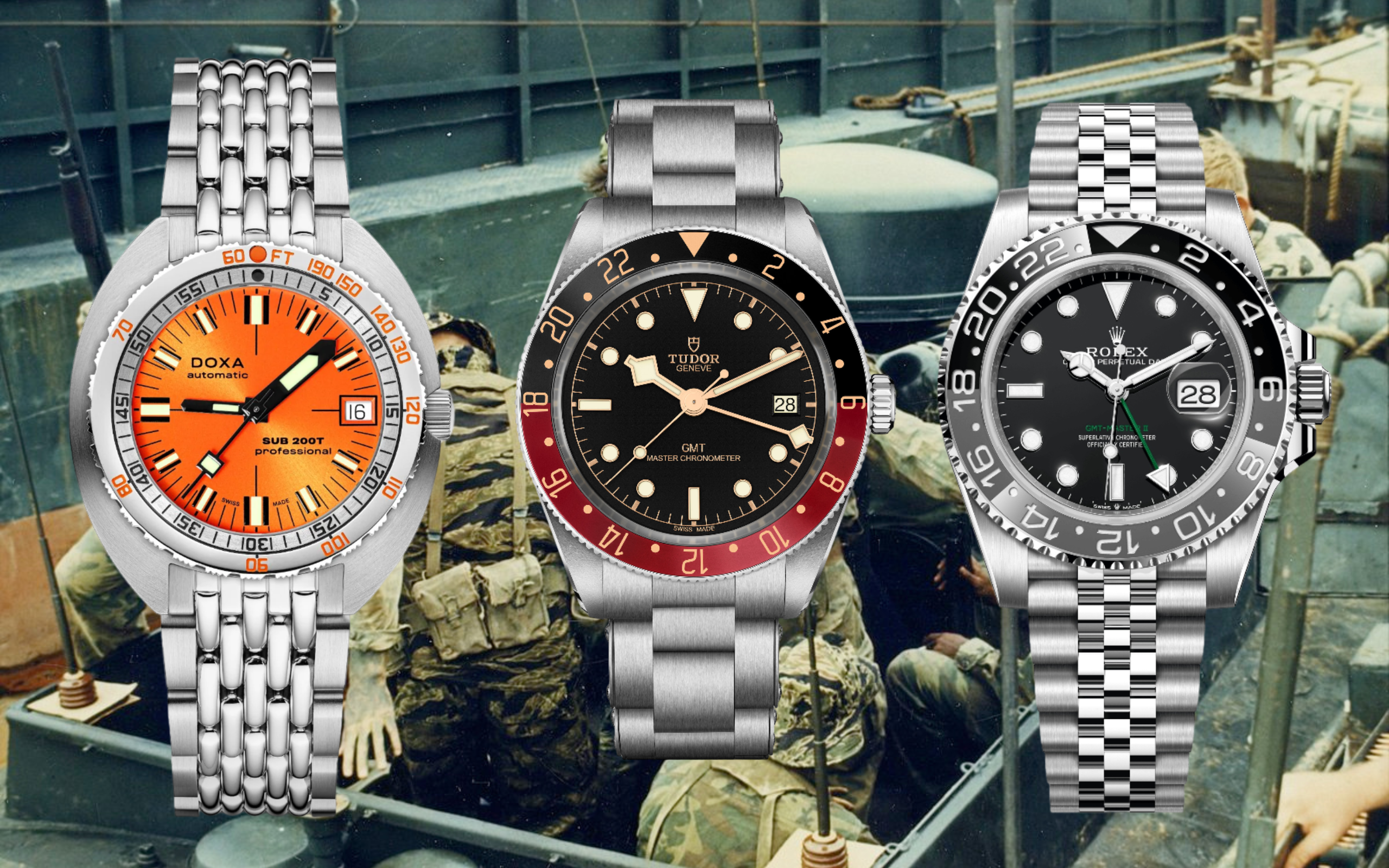
Watches And Wonders Releases For The W.O.E. Community
Last week was Watches and Wonders, a trade show in Switzerland where watch brands showcase their latest releases. Journalists, tastemakers, and watch enthusiasts flock to...
Read OnLast week was Watches and Wonders, a trade show in Switzerland where watch brands showcase their latest releases. Journalists, tastemakers, and watch enthusiasts flock to Geneva to see and photograph new timepieces, meet with brand representatives, and drink no shortage of champagne and Negronis. Watches and Wonders is a masterclass in marketing, also known as the mass manipulation of consumers. We have previously written about covert influence in watch media (READ HERE) and this event is the Superbowl or, if you will, the Fashion Week. Propelled by the rise of digital media, what was once a straightforward industry trade show has been catapulted into the feeds of even the most basic enthusiast, with extensive coverage across all forms of social media, podcasts, and legacy watch publications. Photo Credit: Watches and Wonders For weeks leading up to the event, the internet has been rife with “Watches and Wonders Predictions,” an organic marketing exercise that benefits both brands and content creators. The most influential tastemakers are invited to Switzerland as guests of the trade show, with hotels and other expenses covered either by the Watches and Wonders foundation or the brands. Lavish parties are thrown to showcase the watches but more importantly to woo the journalists, who are then expected to (objectively) cover the new watches, often simply regurgitating press releases with brand-approved language. Whether or not they are invited back next year is implied in part on their coverage of the event or the particular brand that sponsored their attendance. It’s brilliant. Photo Credit: Watches and Wonders Don’t Hate The Player Or The Game To be clear, we don’t hate the players or the game. On the contrary, we admire the masterclass that is Watches and Wonders. It’s a fascinating exercise in human psychology, consumer behavior, and marketing. As enthusiasts, the releases are exciting, the speculation and leaks are admittedly fun, and the grand reveals offer the age-old intrigue of the unknown. While we normally don’t cover new releases, we want to highlight several watches that speak specifically to our community and our “Use Your Tools” ethos. Photo Credit: Watches and Wonders We originally planned to cover 10-12 timepieces, but frankly struggled to identify more than a handful that met our criteria. The industry is trending towards high fashion and this seemed to be the year of dress watches and precious metals, which needless to say is not really within our wheelhouse. These are by no means endorsements, but here are a few that caught our eye. Rolex GMT-Master II Grey-Black Bezel Price: $10,900 (In Theory) A CIA Case Officer has been described as a “Ph.D. that can win in a bar fight”, and that fictional person would (traditionally) wear a Rolex GMT. Whether the updated grey and black bezel on the newest GMT Master II is to your taste is up to you, but we would argue it gives the watch a modern look that is also more subtle than something like the legendary Pepsi bezel. For the traditionalists, the Pepsi is still available and was not discontinued as indicated by the rumor mill. It’s an easy win and we like it. Cons: The days of a Case Officer or SpecOps operator walking into a boutique on R&R and walking out with a Rolex GMT are over. Given the astronomical secondary market prices (at times over double retail for certain references), it’s hard to say a new Rolex GMT is a true tool watch with a straight face. Modern Rolex models tend to be pretty shiny and this new GMT is unfortunately no exception. It can and will still be used as a tool by a select few, but the modern GMT Master II lacks much of its original tool watch feel. Also, good luck getting one at retail. Doxa Sub 200T Price: $1,550 - $1,590 For both the military and recreational diving communities, Doxa is a legendary name, having famously been worn by Dirk Pitt, Clive Cussler’s fictional undersea hero, and in the US Navy’s pioneering SEALAB experiments. Better known for their storied salvaging efforts, US Navy Divers also have been at the pointy end of the espionage spear, responsible for developing and executing a daring mission to tap Soviet undersea communication cables in the 1970s on Operation Ivy Bells. Jumping ahead to 2024, Doxa sneaked in just ahead of the Watches and Wonders releases, unveiling the Sub 200T about a week ahead of the big show. Providing a smaller alternative to the established Sub 300 and 300T, the 200T comes in with a 39mm diameter and more slender case while maintaining much of the Doxa Sub design language. Available in a staggering array of colors and matte or sunray dial finishes, the Sub 200T seems poised to provide a smaller-wearing alternative for those who have traditionally considered Doxa’s chunky cushion case to be a bit too much. Cons: Most Doxa Sub models wear considerably smaller than their stated diameter, meaning this 39mm Sub 200T might wear more like 36 or 37mm on the wrist, pretty small. Tudor Black Bay 58 GMT “Coke” Price: $4,400 - $4,600 While they may not have the historic caché offered by Rolex’s GMT Master models, Tudor’s GMT watches have come a long way since the release of the Black Bay GMT in 2018. However, from that 41mm wide by 15mm thick model’s inception, many were quick to call for a smaller and thinner option. But what most enthusiasts wanted was a Black Bay 58 GMT, and that’s exactly what we got in 2024. At this point, Tudor’s relationship with our community is well-established. Still producing unit watches for some of the world’s most elite military operators, Tudors of Espionage (T.O.E.) are very much a thing. That said, the new Black Bay 58 GMT feels like more of a vintage throwback than a modern practitioner's watch, but still offers its own play on the desirable “Coke” format along with the best set of dimensions thus far for a Tudor GMT, measuring 39mm wide and under 13mm thick. Cons: The new BB58 GMT relies heavily on “gilt” gold-tone markings that aren't for everyone. The faux rivets on the bracelet have to go and it’s really hard to understand why they use them on new designs. There is no utility to this feature and it crosses the line of homage-corny. The nicest thing we have heard about faux rivets is, “...they don’t bother me that much.” Bremont Terra Nova Price: $2,850 - $4,250 We are big fans of Bremont and we've previously covered the UK brand’s intriguing relationships with intel and military units around the globe (READ HERE). It would be intellectually dishonest to ignore the new Terra Nova collection of field watches “inspired by military pocket watches of the early 20th century”. That said, it’s hard to sugarcoat this one. To use a cricket metaphor, it was a swing and a miss. The rebranding fell flat with both enthusiasts and Bremont traditionalists. Prior to the event, newly appointed Bremont CEO Davide Cerrato (formerly of Tudor, Montblanc, and Panerai) foreshadowed a pivot to a lower price point and we were genuinely excited about these releases. The strategy was sound but the implementation was flawed. The Terra Nova and the redesigned Bremont Supermarine are a stark departure from what makes Bremont loved by many, standing out as classy and refined aviation-inspired watches. Cons: The list is unfortunately long. The new logo, font, and overall design and manufacturing quality fall well short of expectations. To make matters worse, the price range places it squarely in competition with the likes of Tudor and many others. On the bright side, the brand appears to still offer the previous models (with original branding) and Special Projects appear unchanged. Understanding that a full pivot like this is bold, and takes a lot of time, effort, and money, we would love to see Bremont bounce back from this and return to its roots. Tudor Black Bay Monochrome Price: $4,225 - $4,550 We didn’t set out to profile two watches from the same brand, but Tudor came in with another solid (though predictable) win, not our fault. A follow-up to last year’s redesigned 41mm Black Bay Burgundy that added additional strap and bracelet options as well as METAS certification, the new Black Bay Monochrome makes one of Tudor’s single strongest arguments for a vintage-inspired sports watch to wear every day. Though we’ve often argued the Pelagos 39 is the modern Tudor-Sub, the Black Bay Monochrome is now right up there with a slimmer case design compared to previous iterations and more subtle looks than something like a ceramic Rolex Submariner. In our opinion, this is a major step up from the Black Bay 58, which we also love. Cons: If forced to nitpick a great watch, again enough with the faux rivets. Fortunately, this watch is also available with a “Five-Link” (Jubilee) or an integrated rubber strap, both of which feel like better moves. Zenith DEFY Revival A3648 Price: $7,700 It’s not a name we talk about all the time in our shadowy corner of the watch world, but Zenith is a brand we respect and is also doing some very interesting things in 2024. Better known for its contributions to the world of chronographs, having unveiled one of the automatic chronographs in 1969 with the El Primero, modern Zenith balances a collection of up-to-date designs and heritage. This particular inclusion in this list is slightly less about being an ideal watch for Intel/Spec Ops and more about simply being a great new luxury tool watch. Completely overshadowed by the collection of chronographs, Zenith also produced several chunky yet capable dive watches in the late 1960s and 1970s including the rarely-seen Defy A3648. It’s not going to be for everyone, but the modern DEFY Revival A3648 is a near 1:1 of the original with a 37mm case and a very old-school feeling bracelet. With no less than 600 meters of water resistance, it’s also as capable a dive watch as you could ever want while offering a serious splash of orange on the bezel, dial, and hands that will speak to dive watch enthusiasts. Cons: It’s awesome they made this thing 37mm, but a lot of modern-day collectors might not be able to handle the lack of girth. Bright colors on watches are not for everyone (myself included), and a more subtle option might be cool to see in the future. Grand Seiko SBGJ277 Price: $6,800 Like Zenith, we seldom talk about Grand Seiko, instead concentrating on Seiko’s well-established and legendary historical associations with military special operations. With that in mind, Grand Seiko has operated as a separate brand for years now and provides some of the best watchmaking in its price category. The newly-released SBGJ277 leans into Grand Seiko’s history with high-beat mechanical calibers, in this case operating at 5 hz or 36,000 VPH. In addition, this new member of the brand’s Sport collection offers 100 meters of water resistance and a 55-hour power reserve, more than enough to suit the average Case Officer while differentiating from the established Rolex and Tudor crowds. Cons: While the finishing on this SBGJ277 is impressive for the dollar amount, the additional polished elements and textured dial both serve to create a more refined and therefore less utilitarian look. It’s not to say you couldn’t “Use Your Tools” with this watch but rather that it doesn’t look or feel the part as much as some others on this list. Again, we are not necessarily endorsing these watches, but each of them caught our eye and calls for a closer look. We understand that these watches are not cheap and if you’re interested in learning more about entry-level options that are well-suited to our community, check out “Best Watches Under $1,000 - Ask the Experts.” Next week we will resume our regular programming. *sponsored by Rolex, Doxa, Tudor, Zenith, Bremont, and Grand Seiko (Just Kidding) -- If you enjoyed this article, please consider signing up for our weekly free newsletter for further updates HERE. READ NEXT: Remembering the Legacy of Billy Waugh Through His Watches
Read On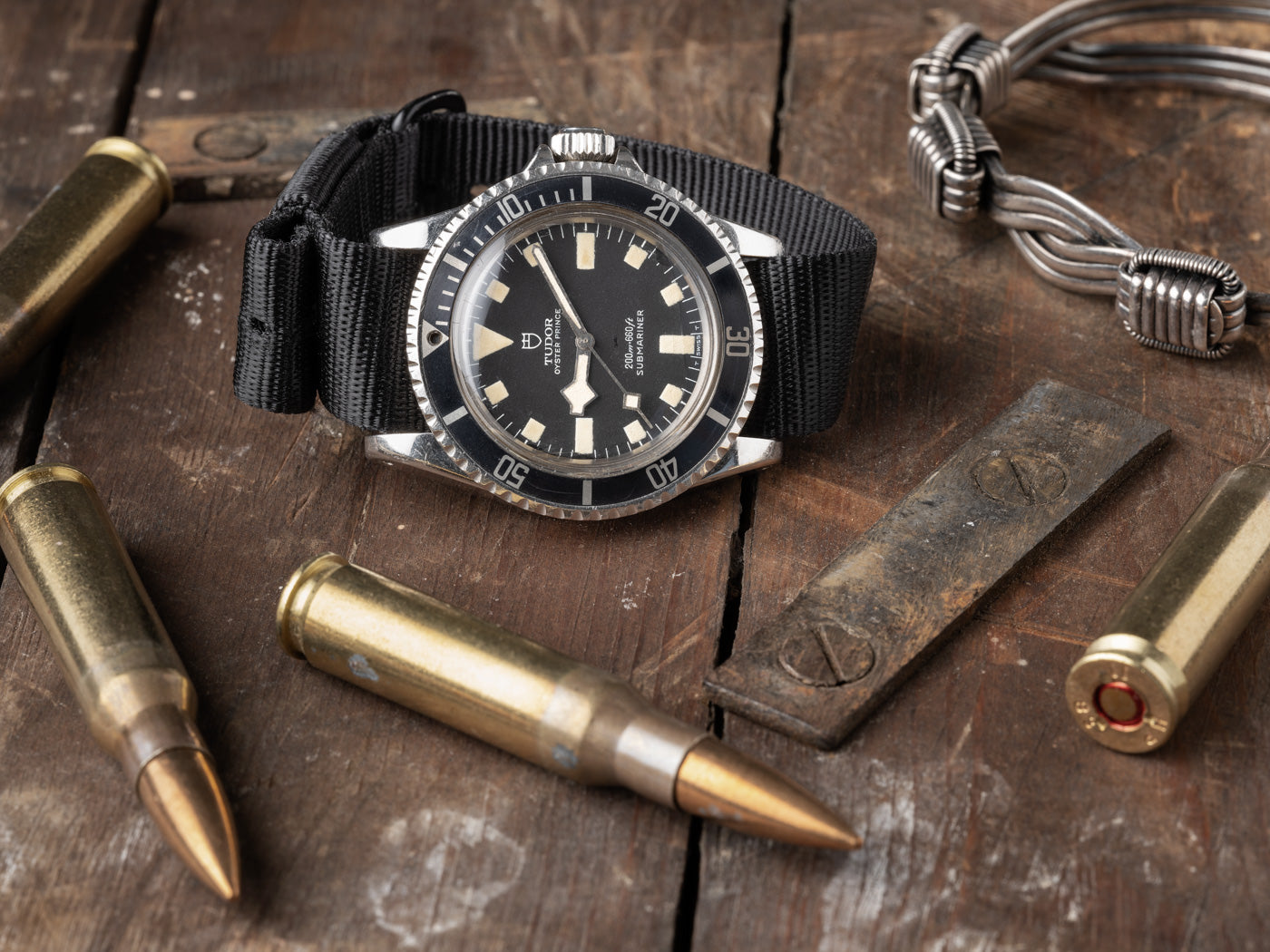
South African Issued Tudor Submariners - Making Time Podcast
Our good friends Darren and Ross Povey from Tudor Collector discussed the history of military issued Tudor Submariners on the most recent episode of “Making...
Read OnOur good friends Darren and Ross Povey from Tudor Collector discussed the history of military issued Tudor Submariners on the most recent episode of “Making Time” podcast. We plan to do a complete W.O.E. Dispatch on South African MilSubs in the future but this is a great opportunity to learn about the history of Tudor and various military watches from the expert. South African MilSubs are controversial pieces given the ties to the South African Defence Force, but they are fascinating snapshots into that period of history. Pictured above is a black 7016 from approximately 1974. I acquired this piece from Ross when I visited Z.A. Straps in Liverpool last year and it is the crown jewel of my collection. There are fewer than 10 confirmed pieces. As many of you know, I have spent much of my life living and working in Africa and this piece has long been a “grail” watch for me. It’s an honor to be the custodian today. See above for the story of the watch and how W.O.E. became the lucky owner.
Read On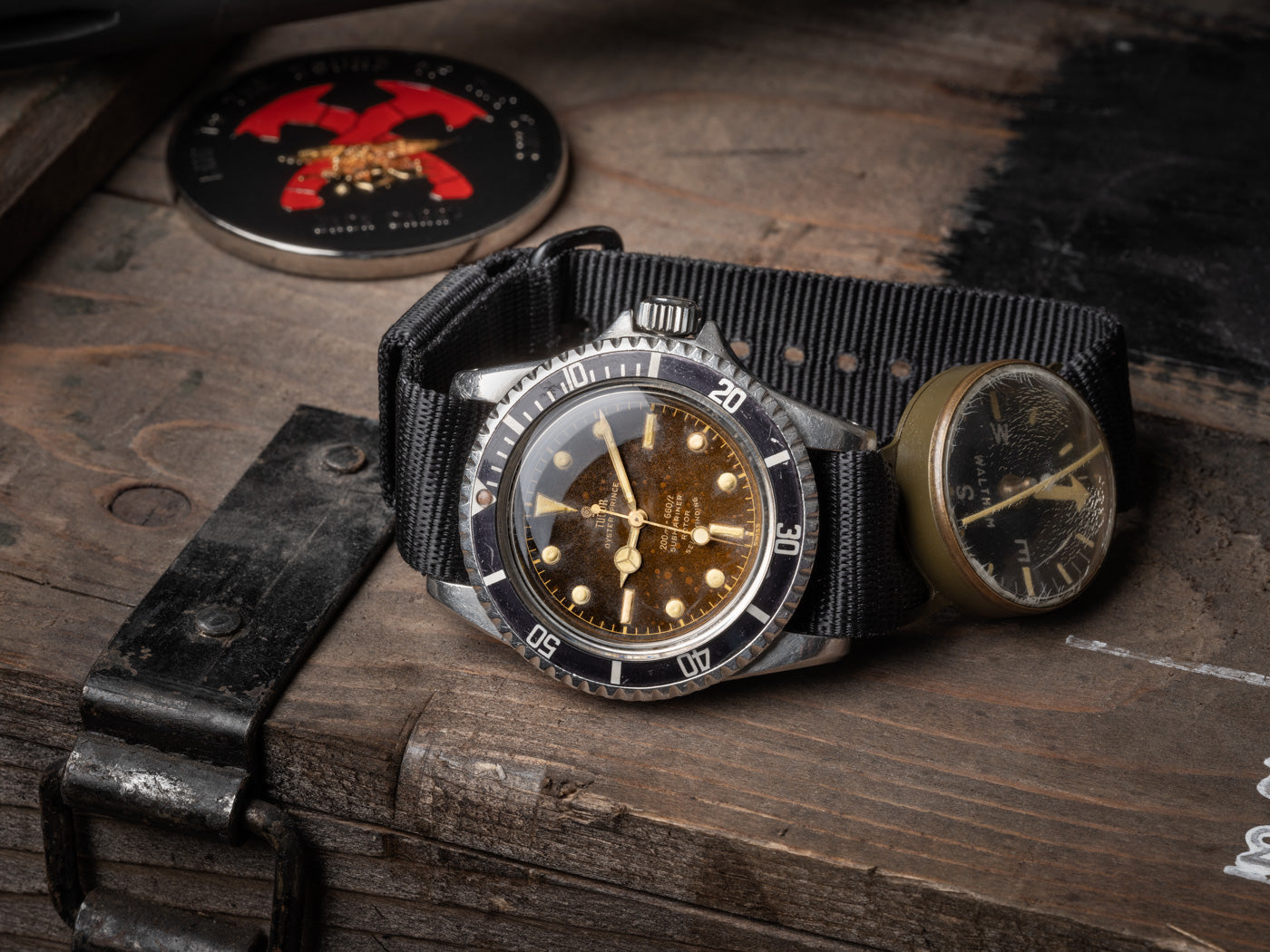
A Brief History Of The Dive Watch - How The Military Helped To Shape History’s Greatest Tool Watch (Part Two)
Benjamin Lowry - If you’re new here, you’ll want to go back and read part one (HERE) of this two-part series where we detail the...
Read OnBenjamin Lowry - If you’re new here, you’ll want to go back and read part one (HERE) of this two-part series where we detail the history of the earliest diving-specific watches and their crucial links to military organizations including Italy’s Decima Flottiglia MAS, the US Navy’s Underwater Demolition Teams (UDT
Read On